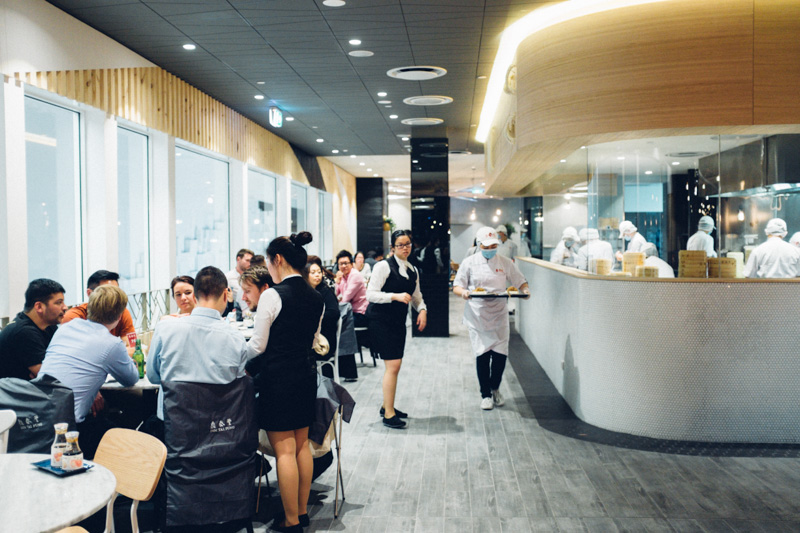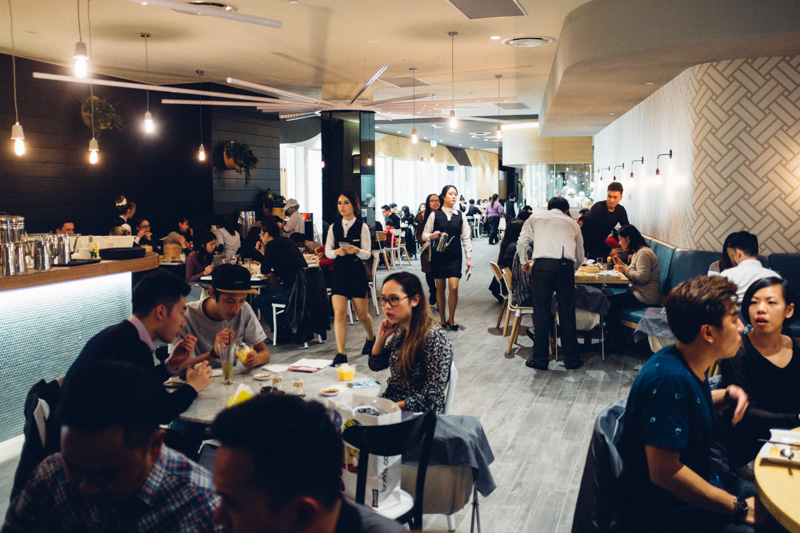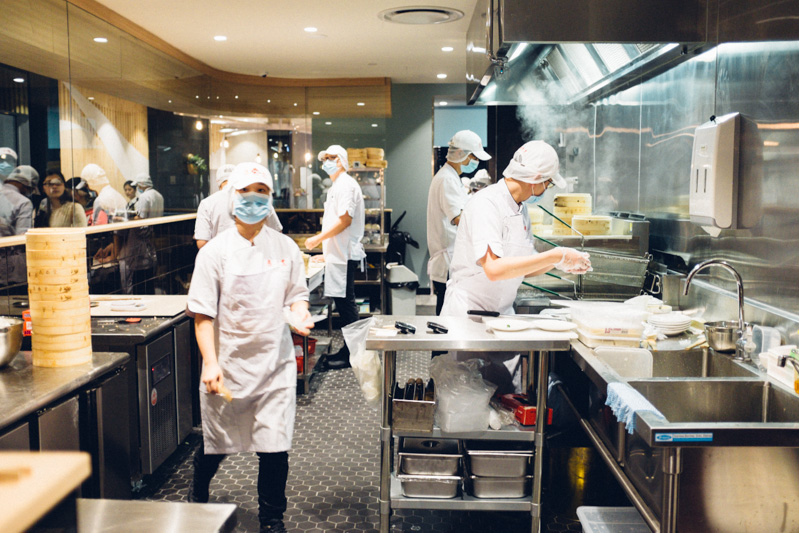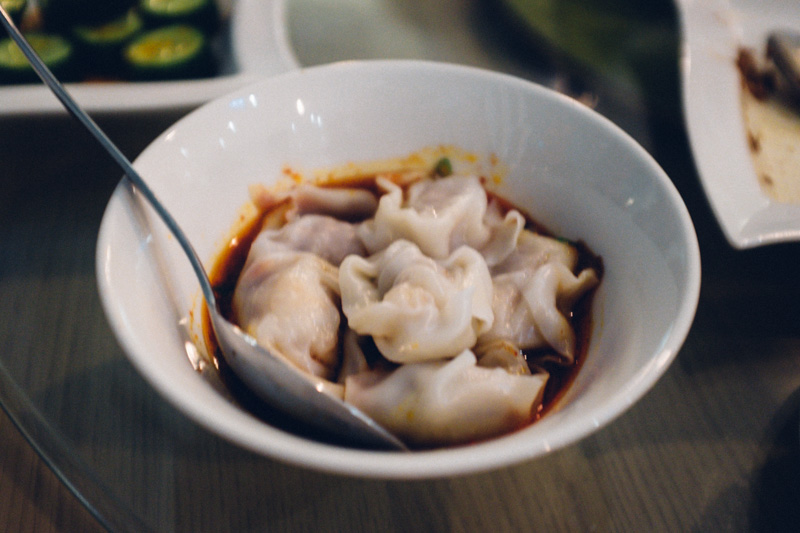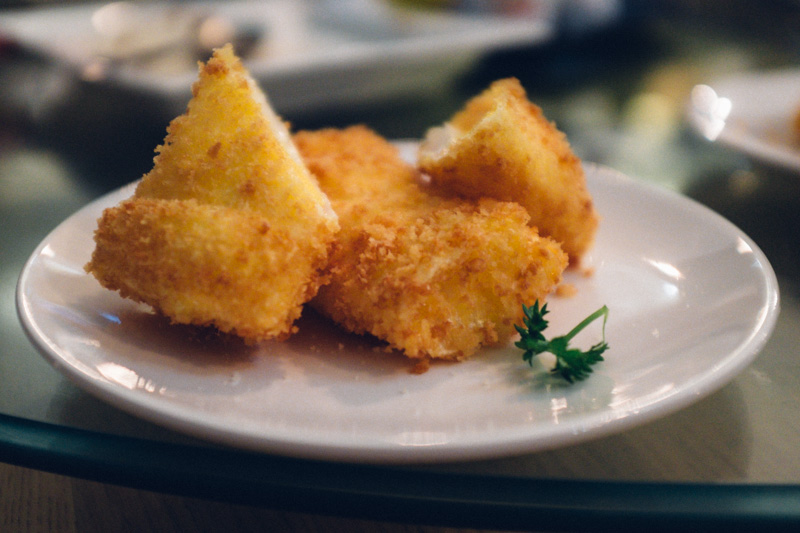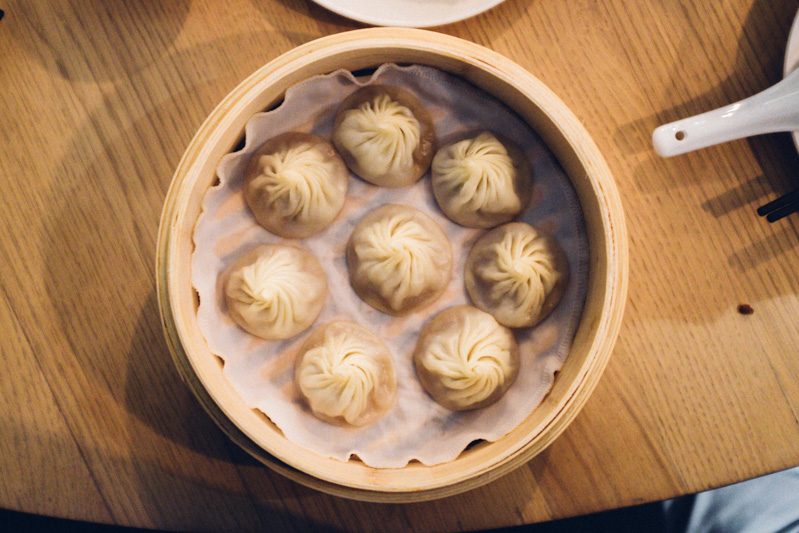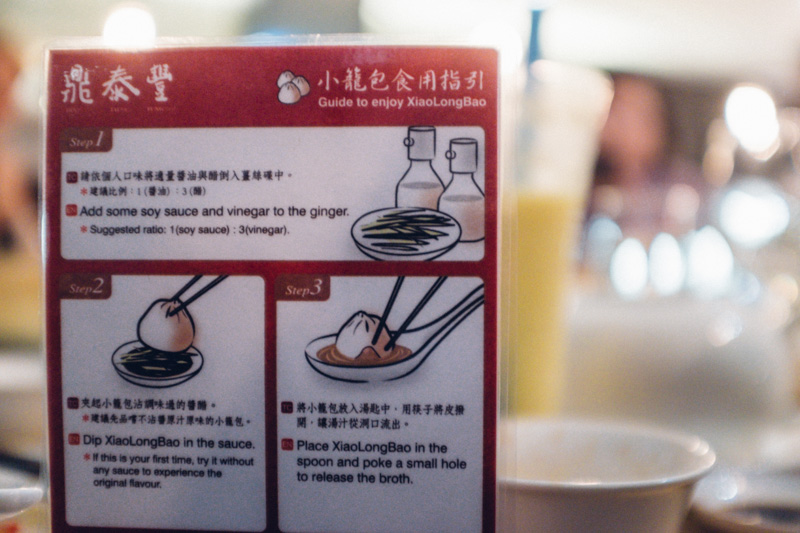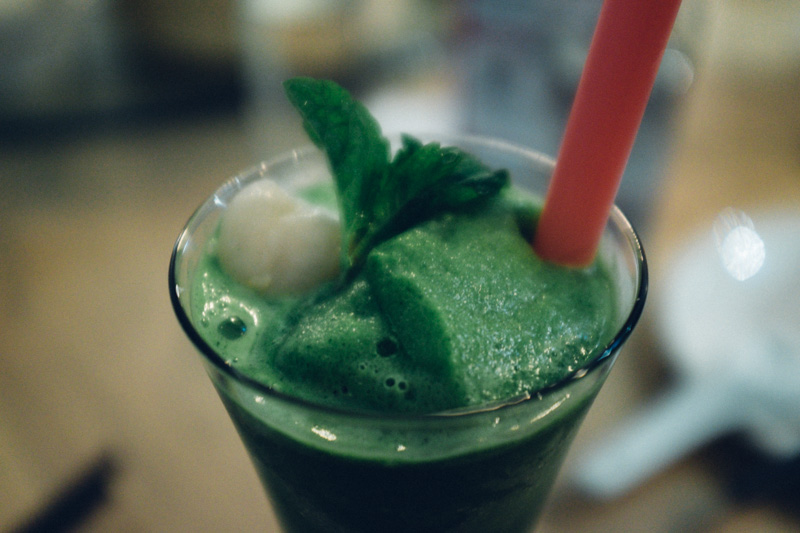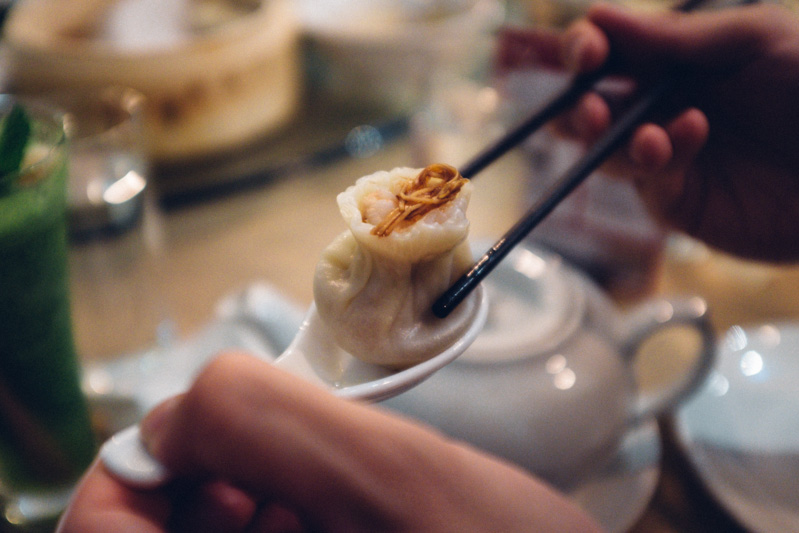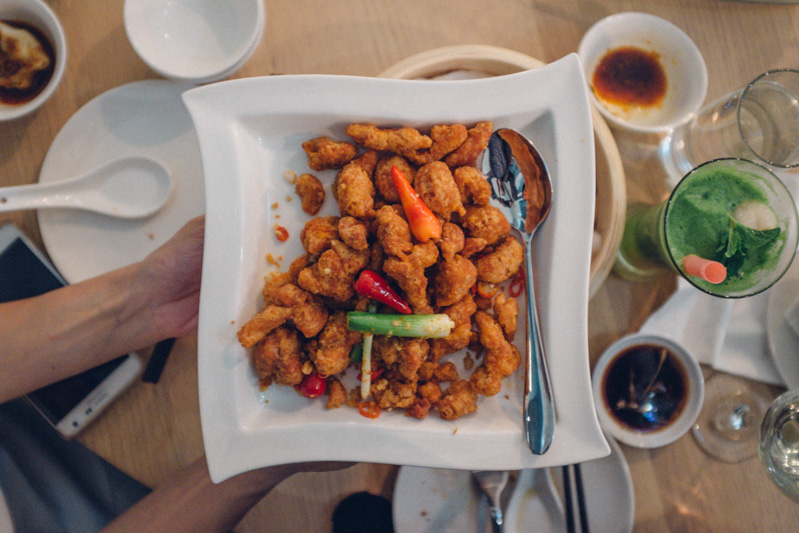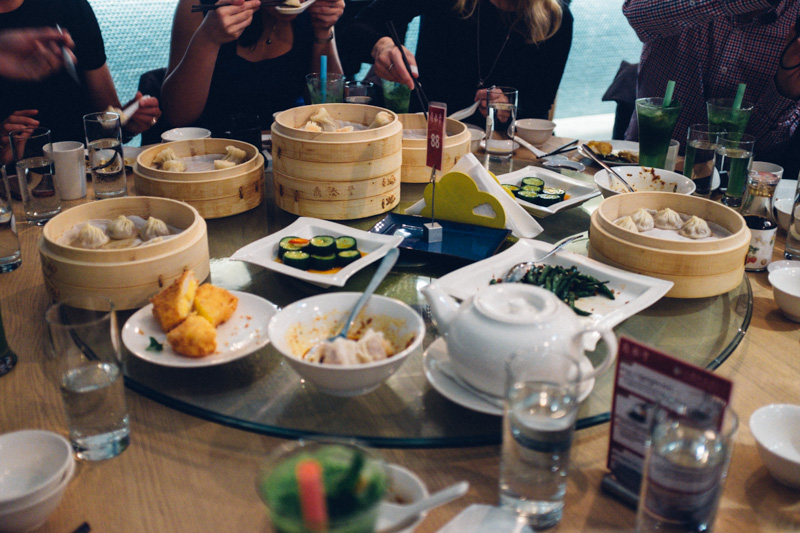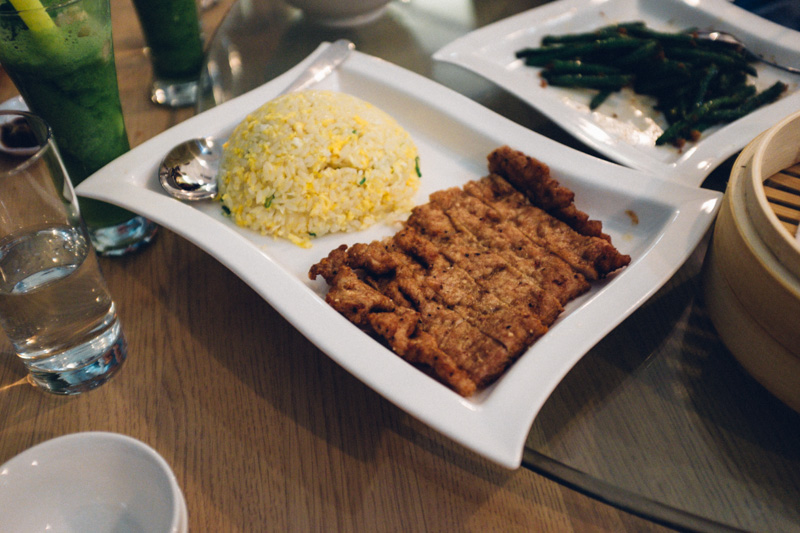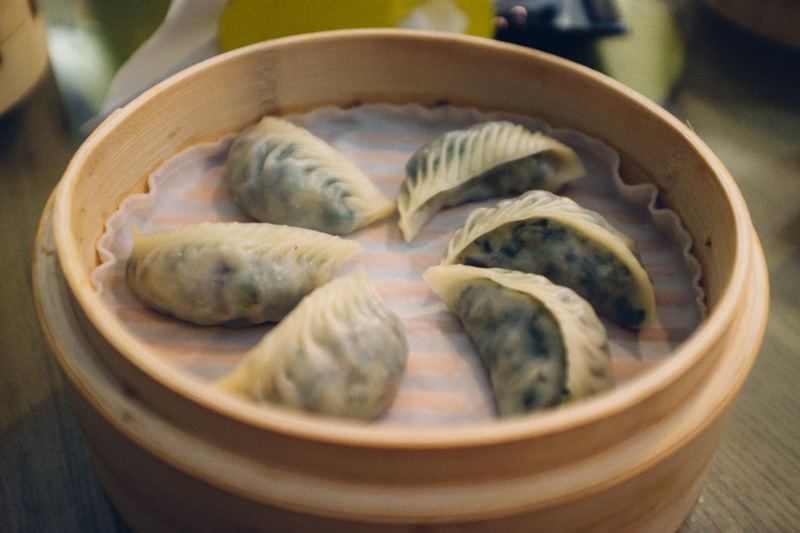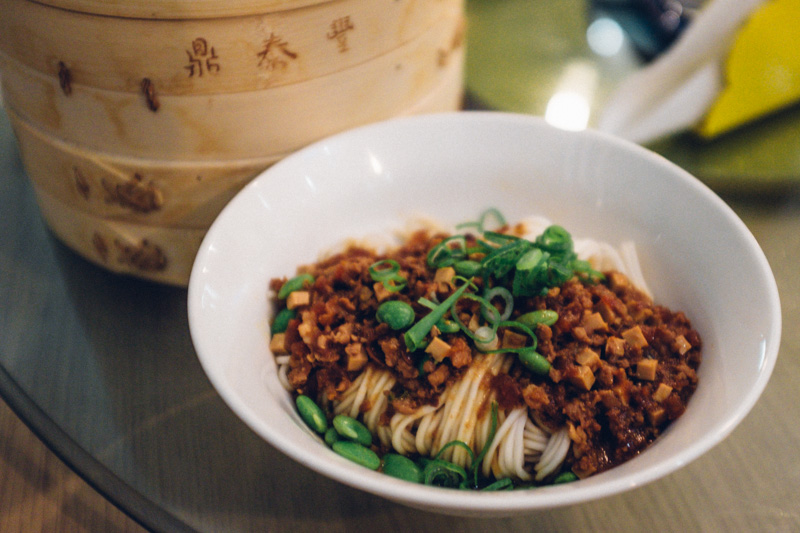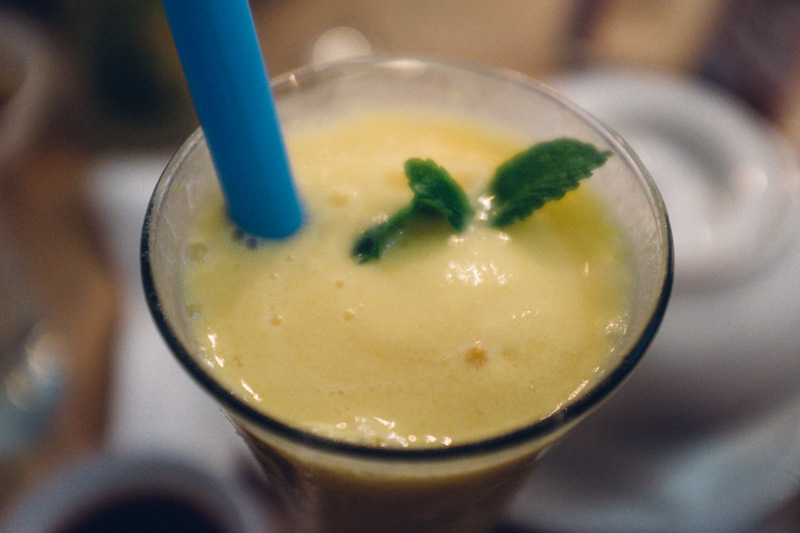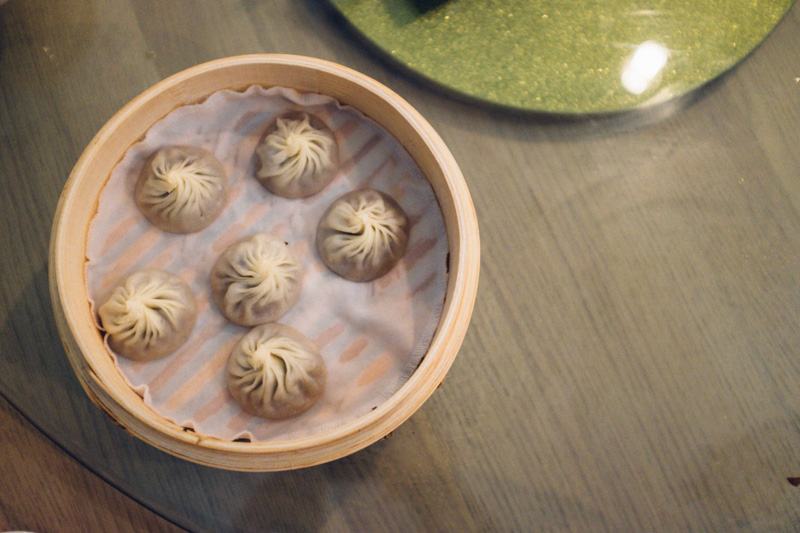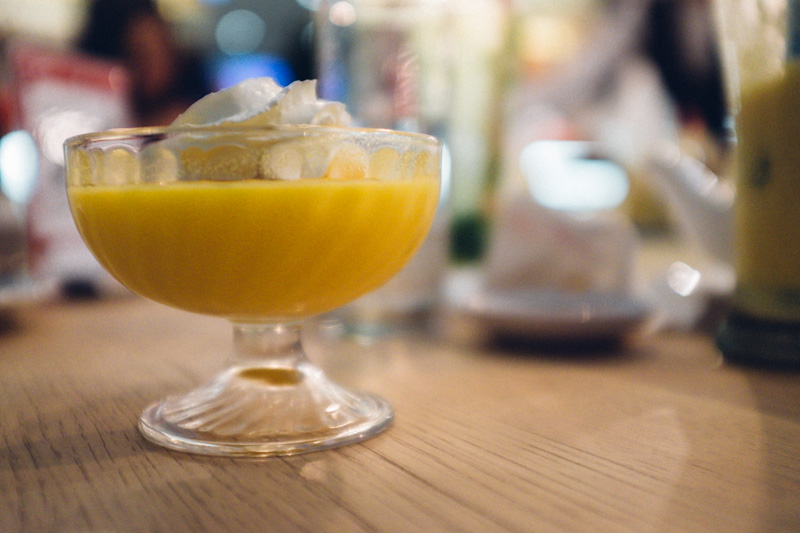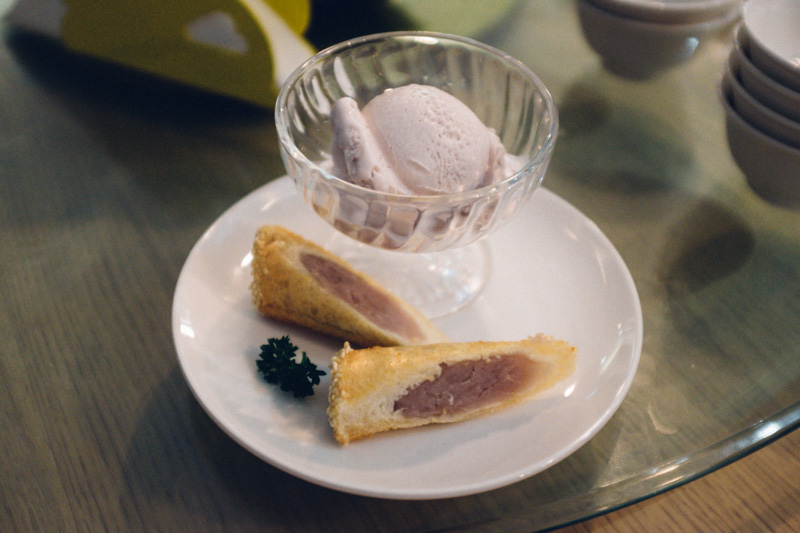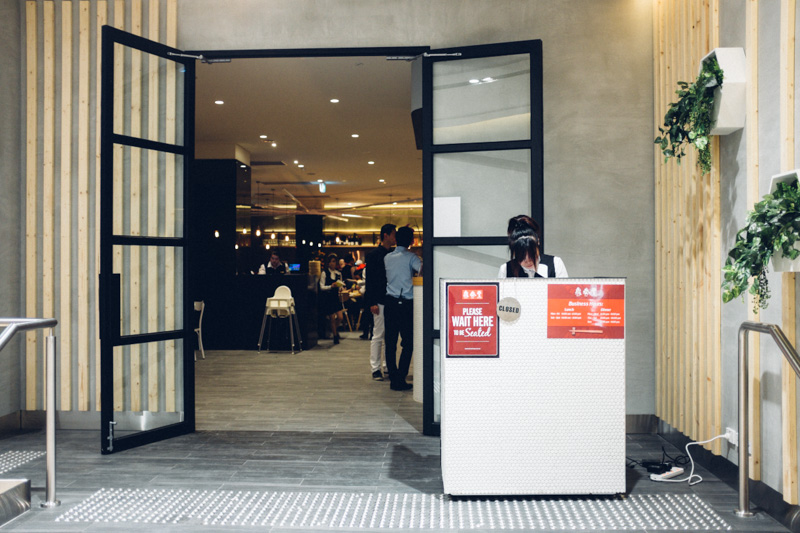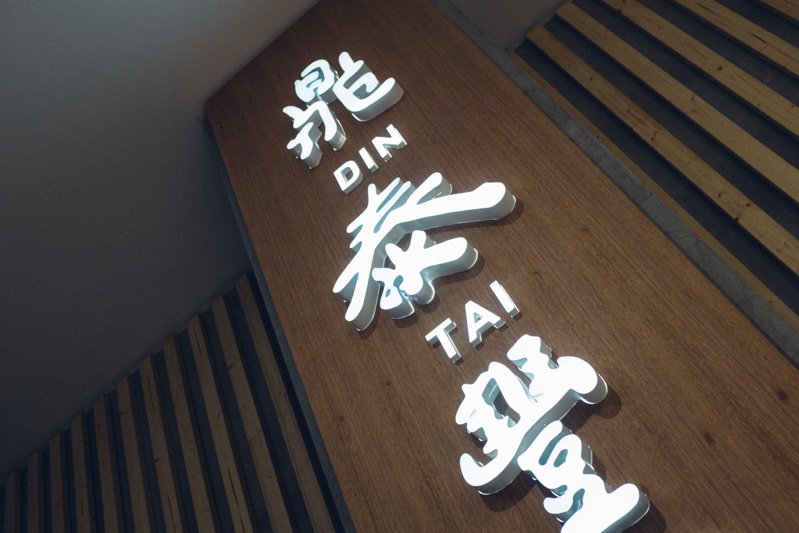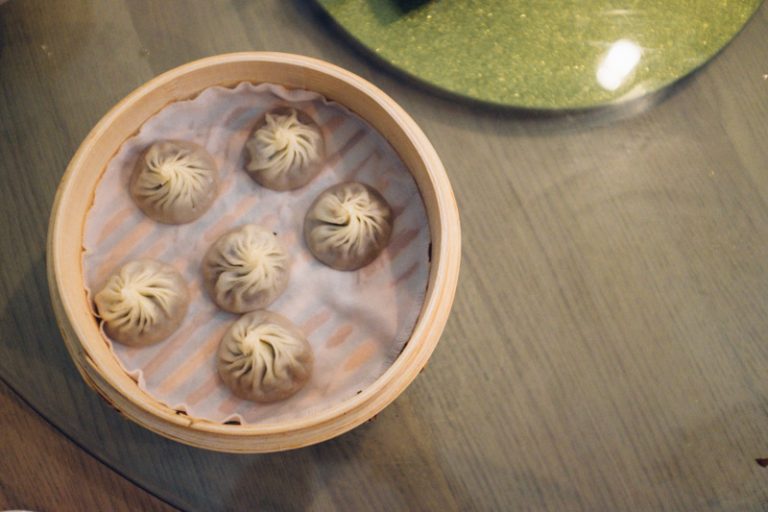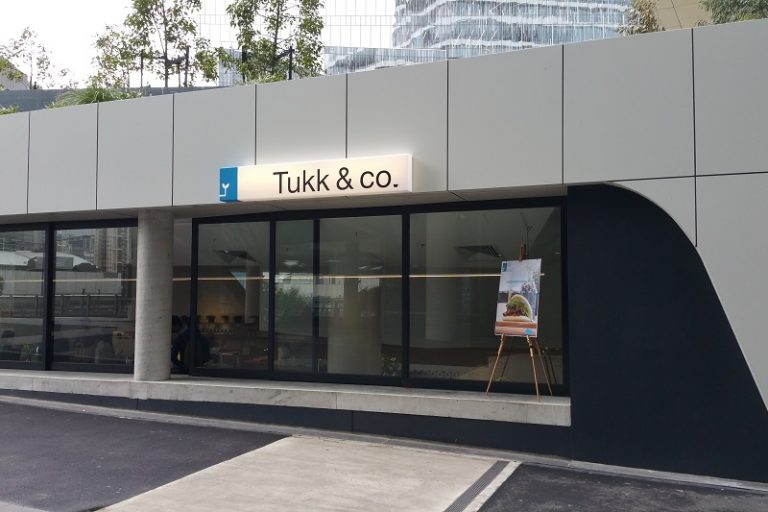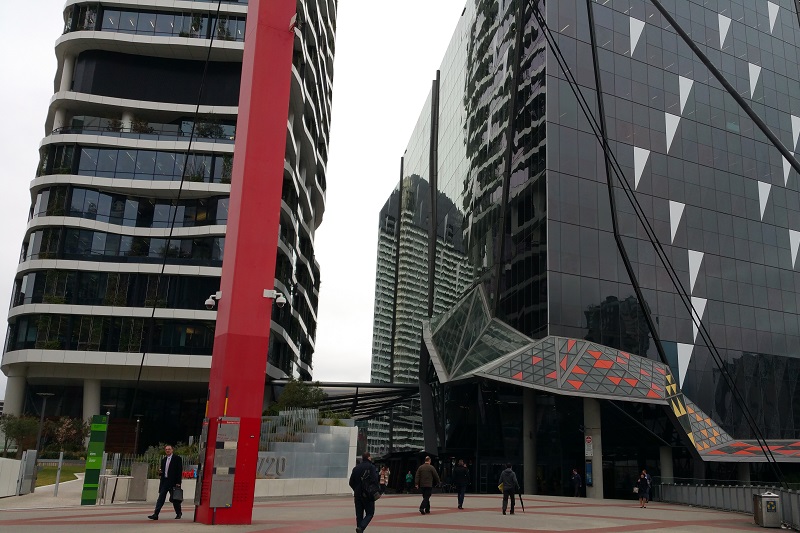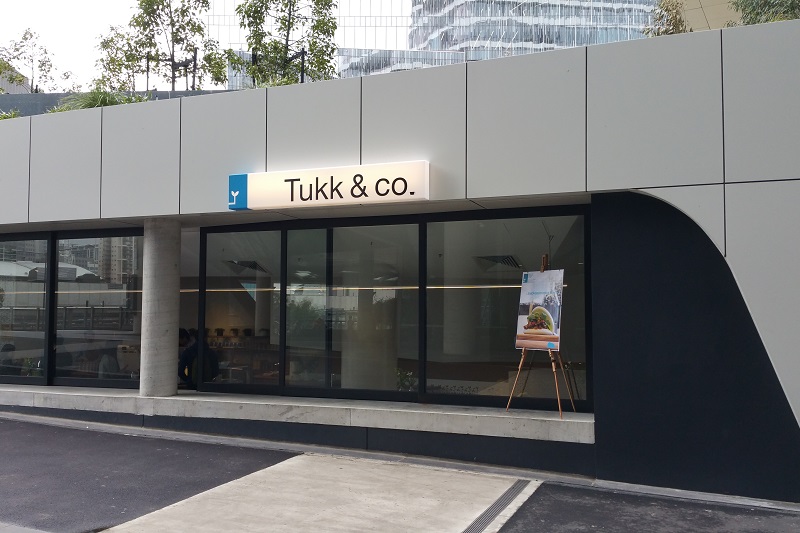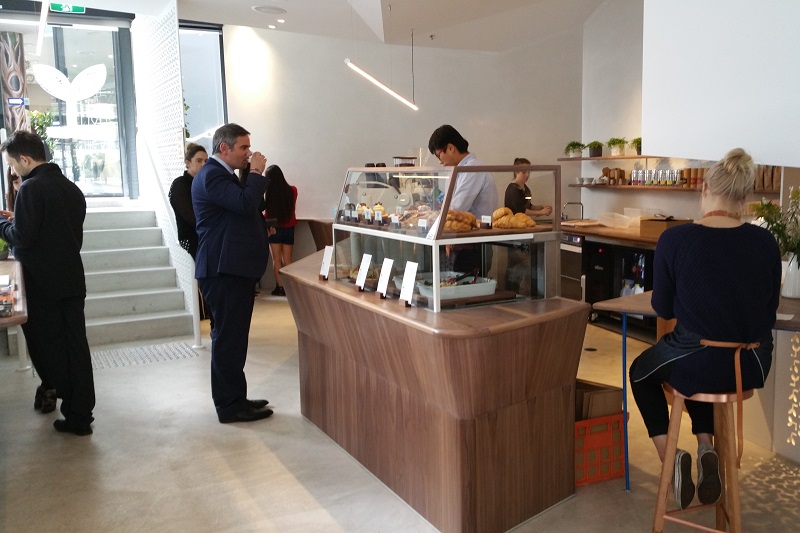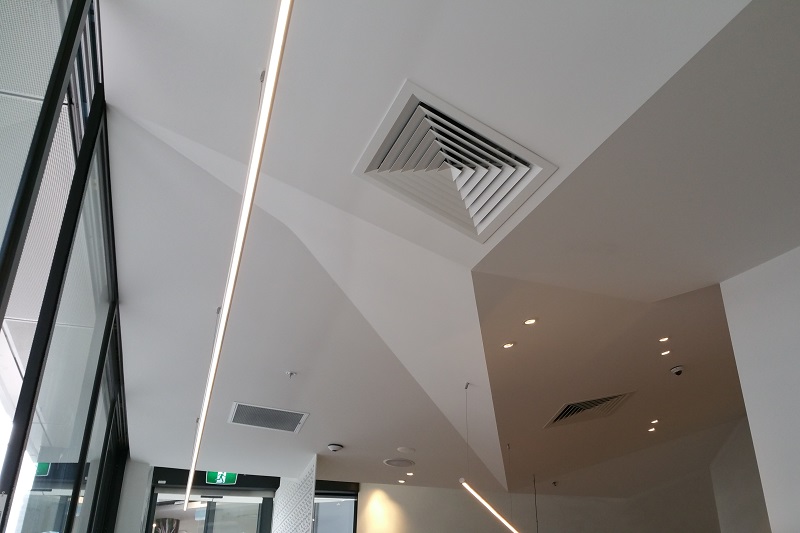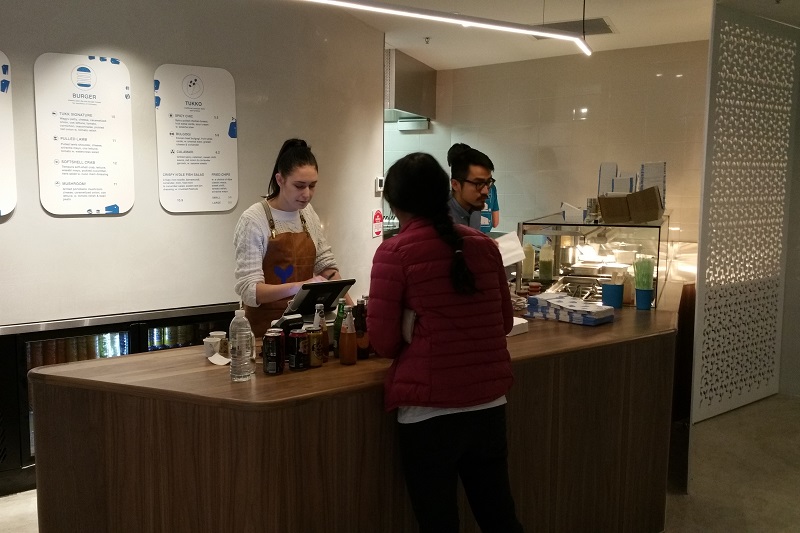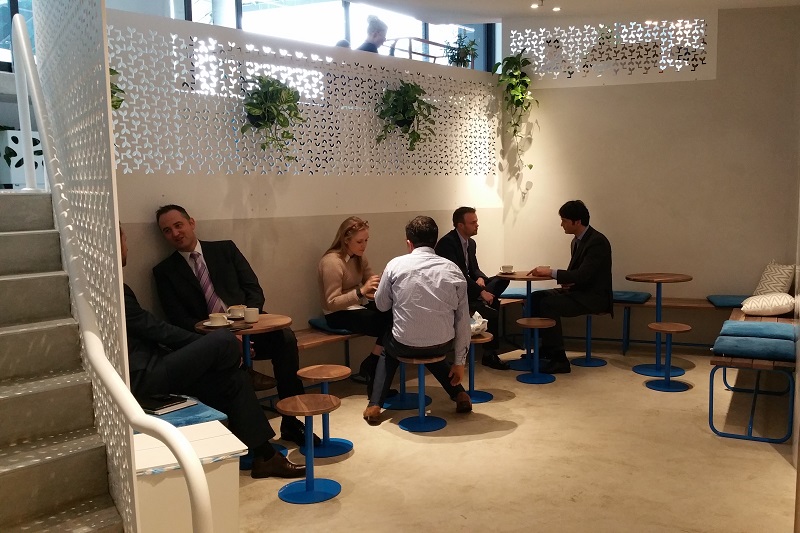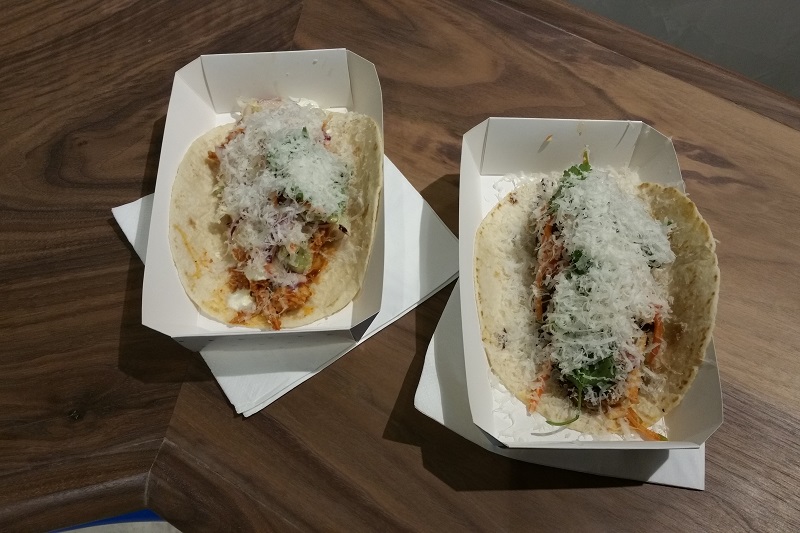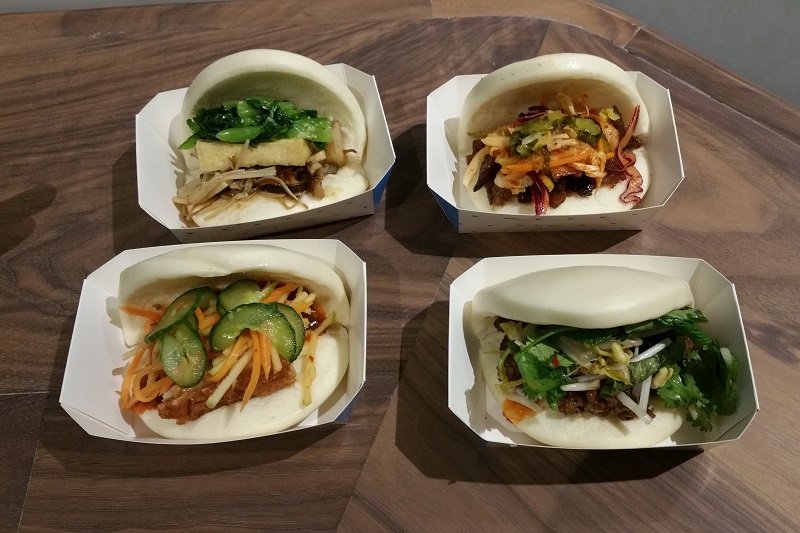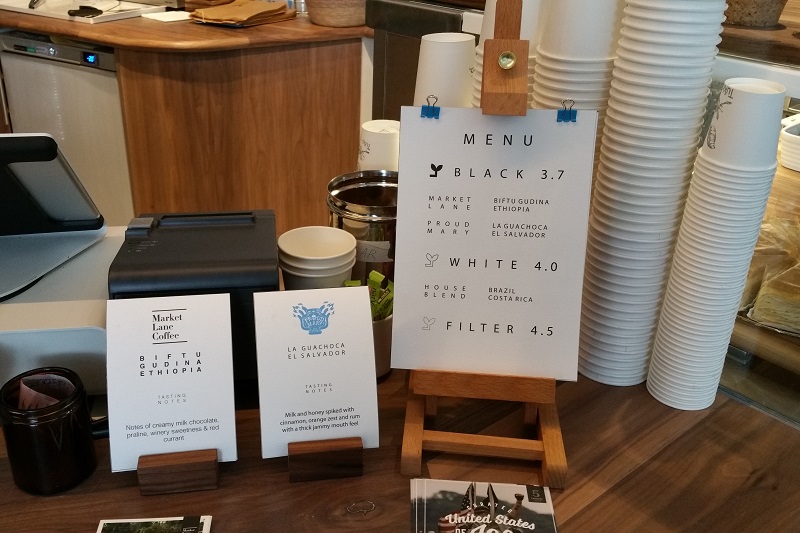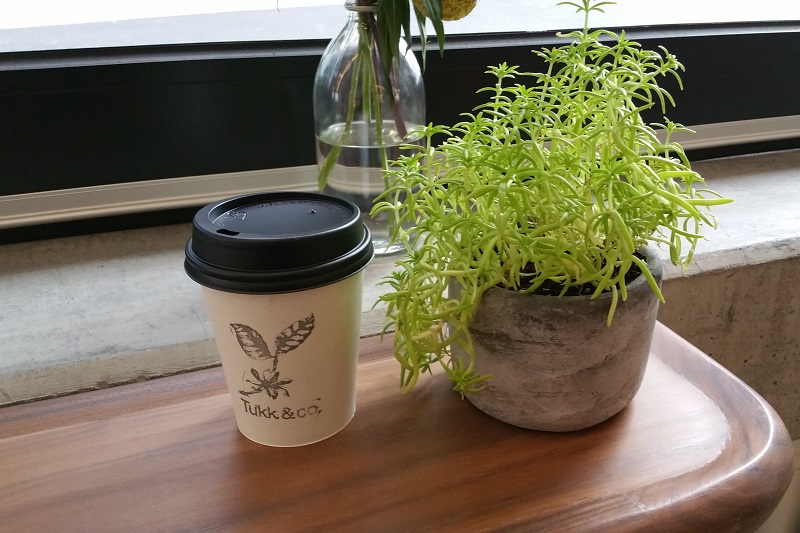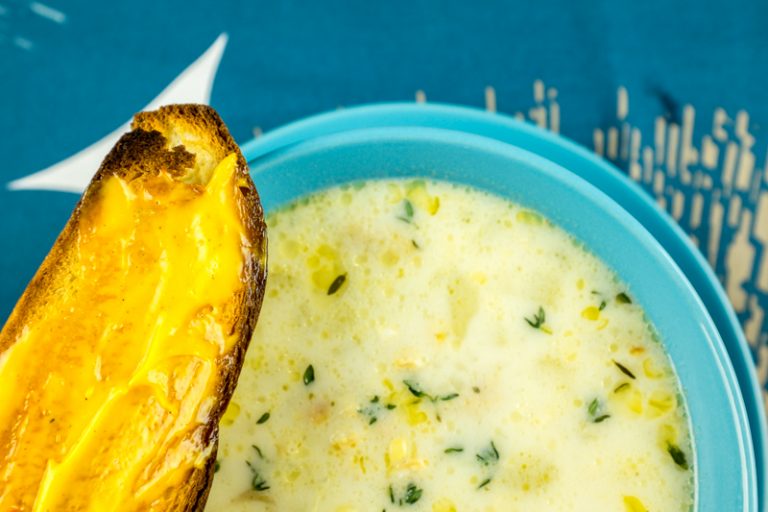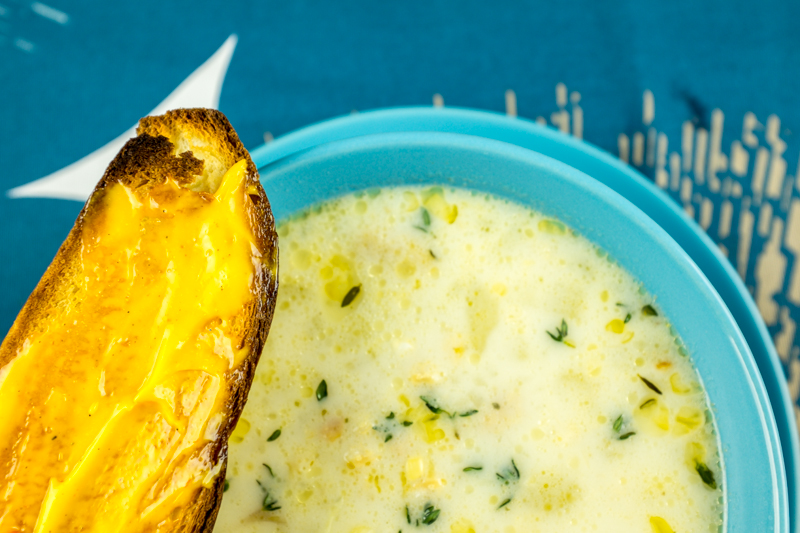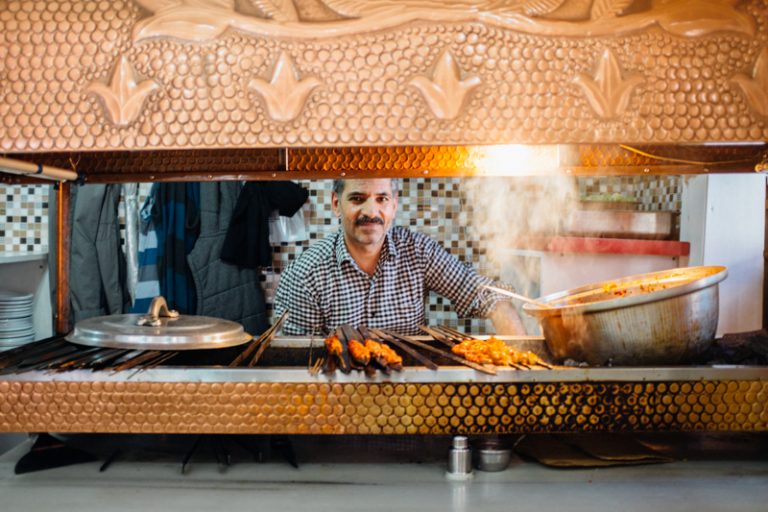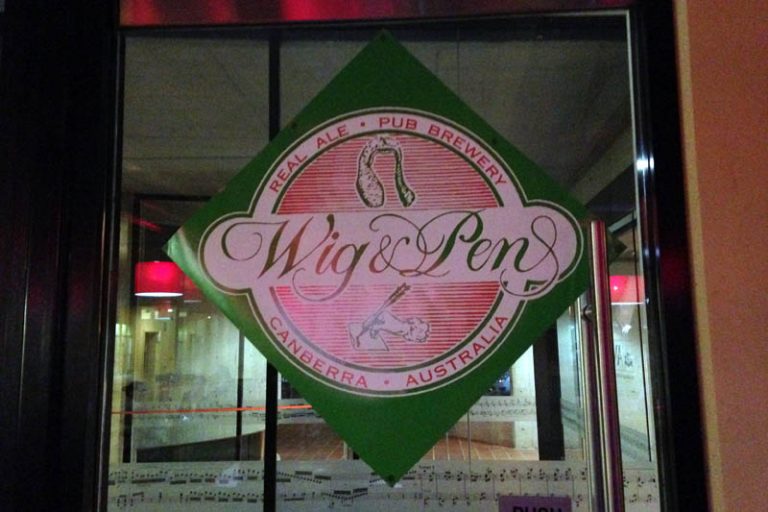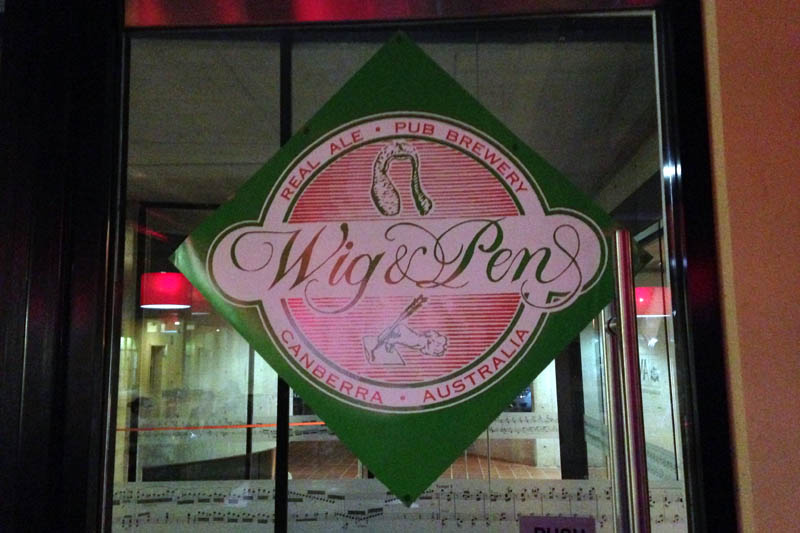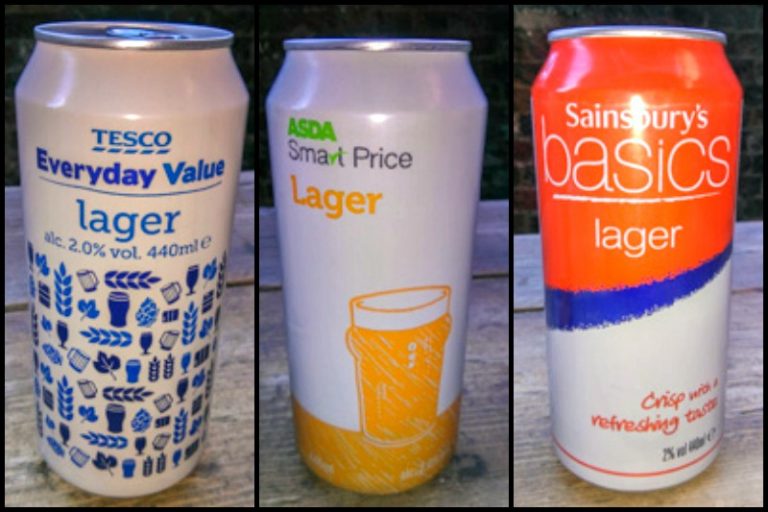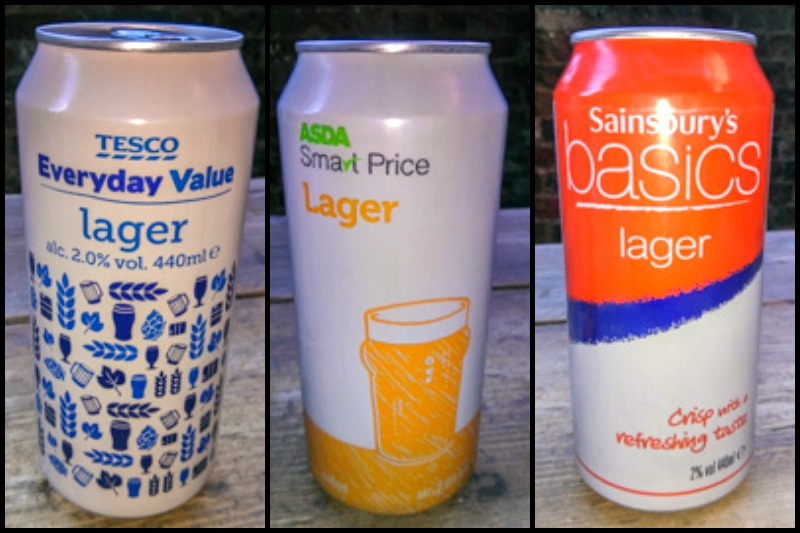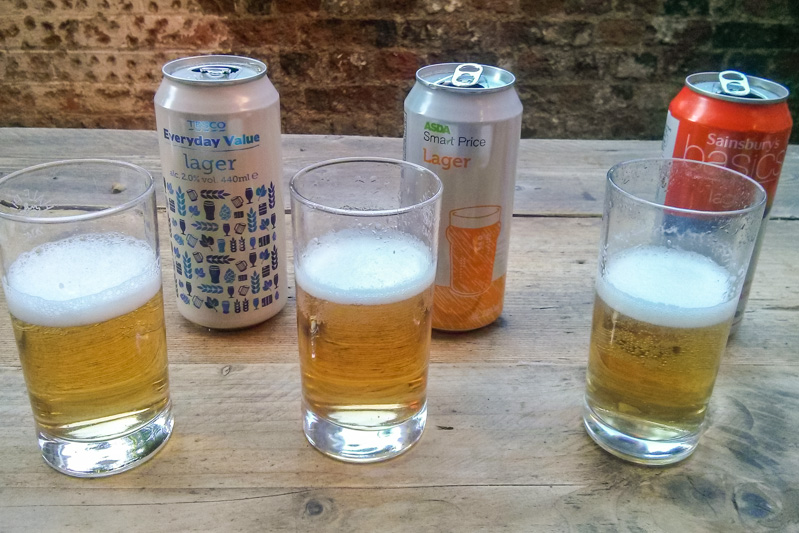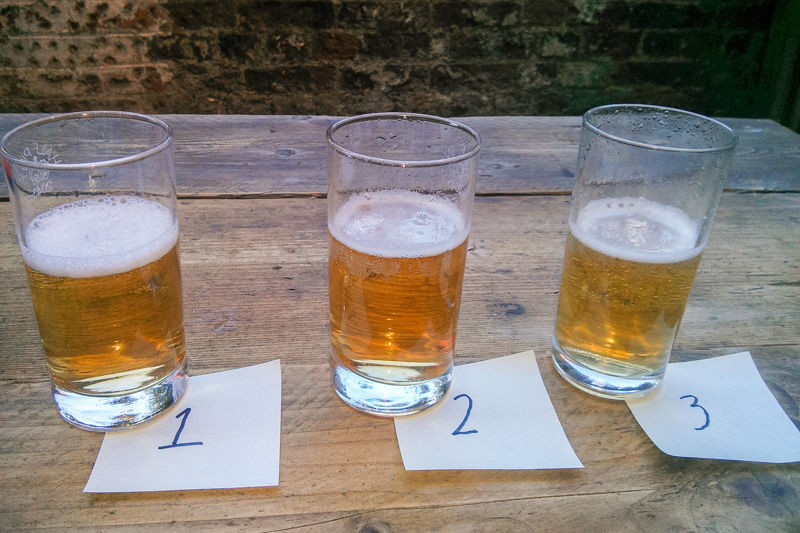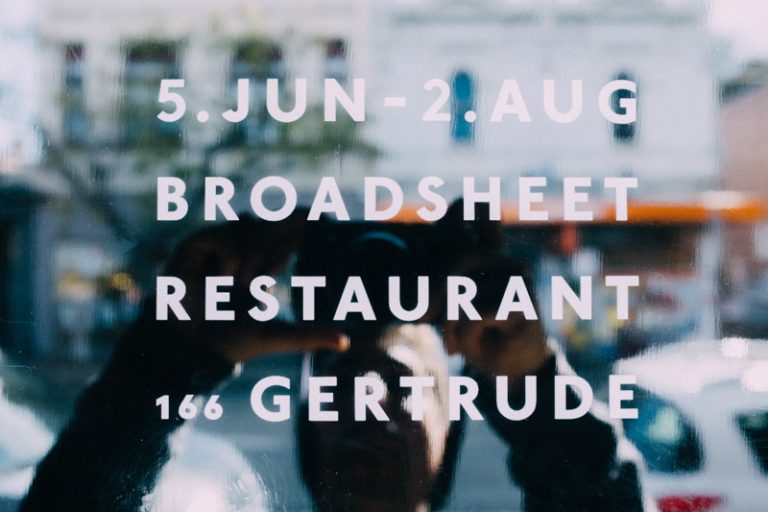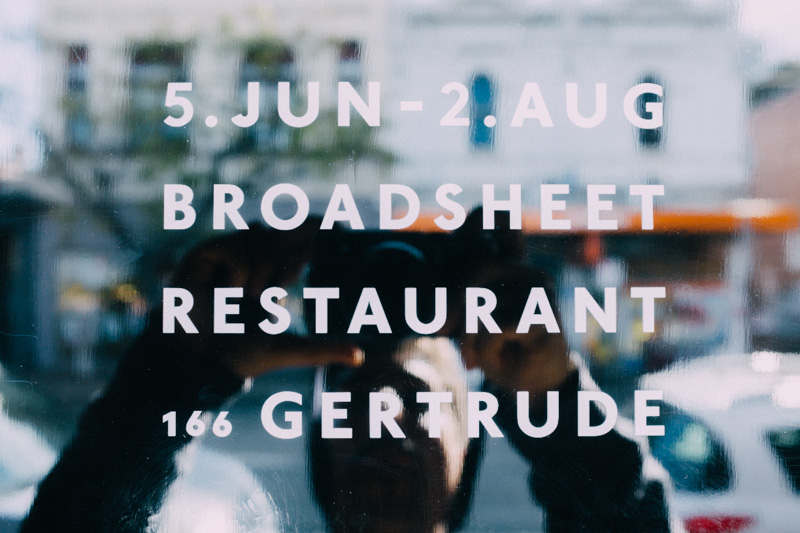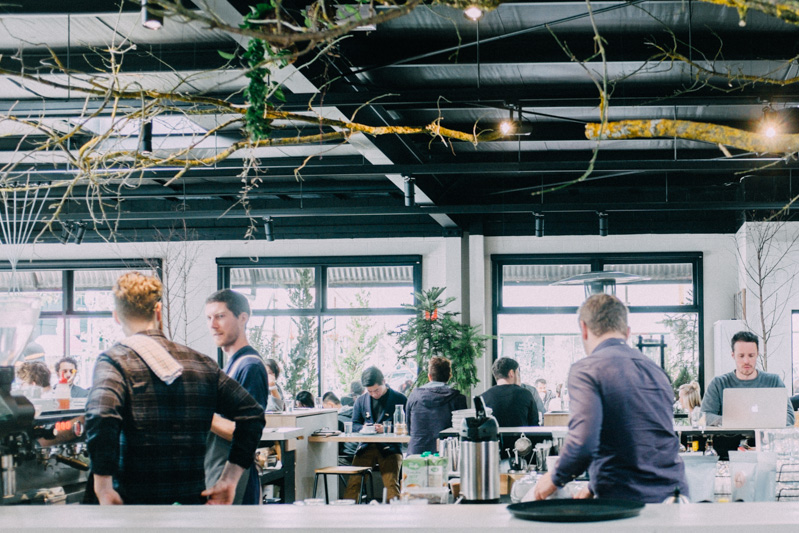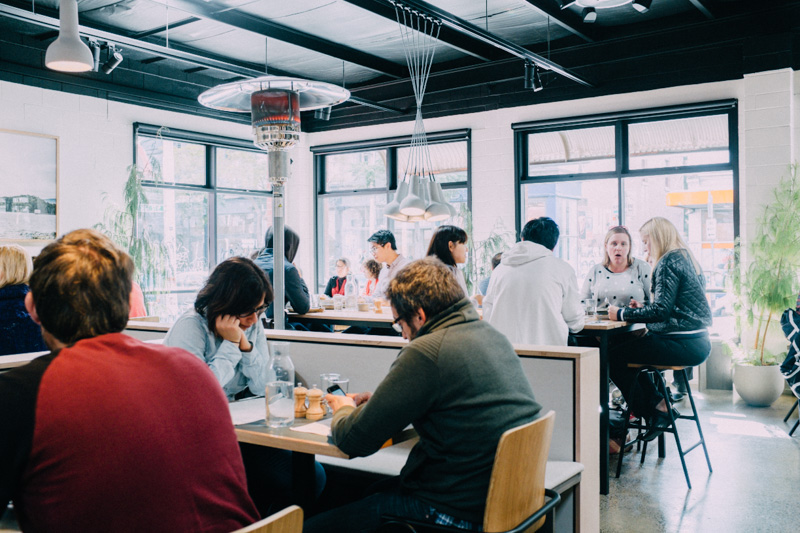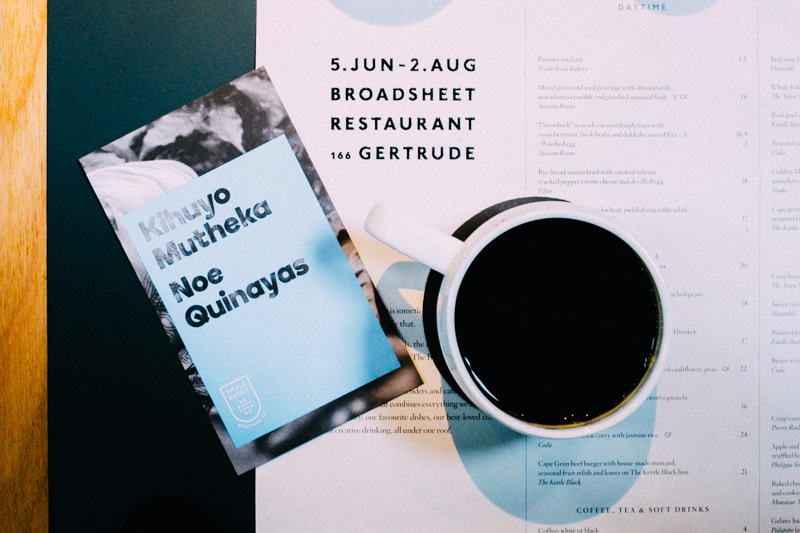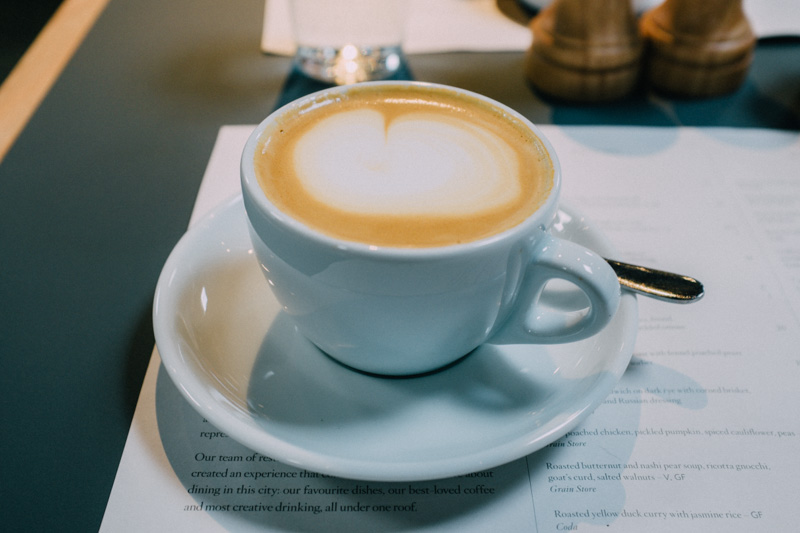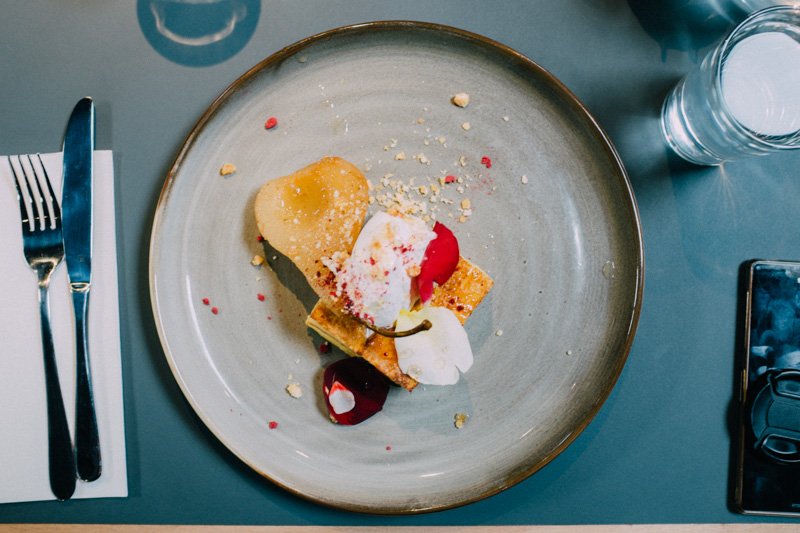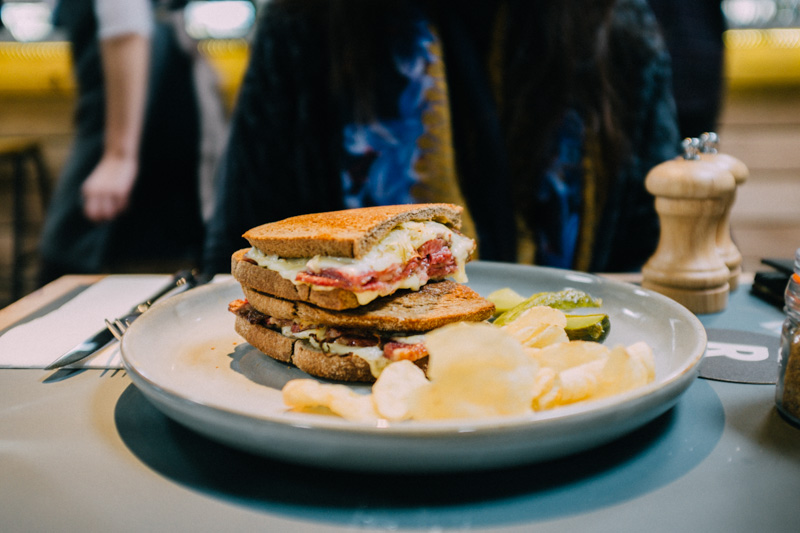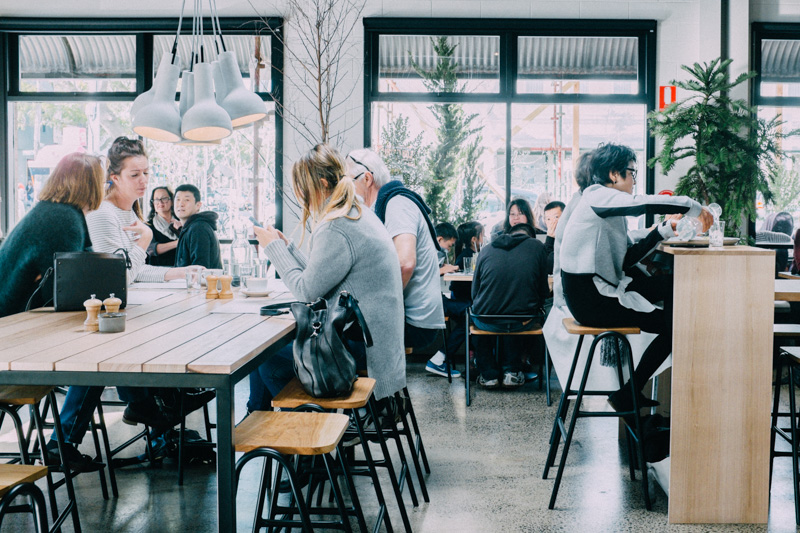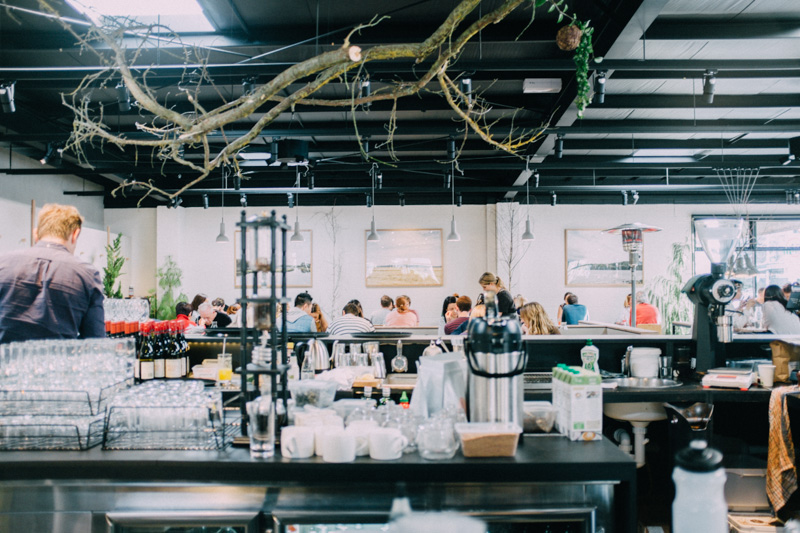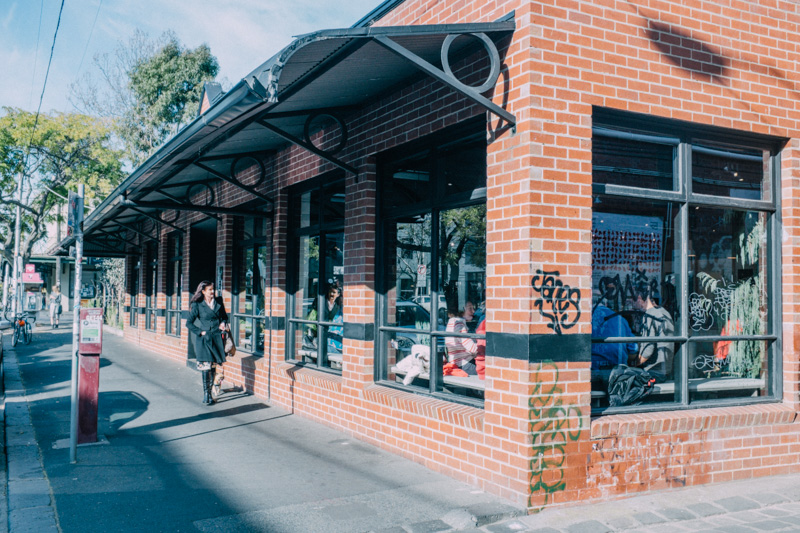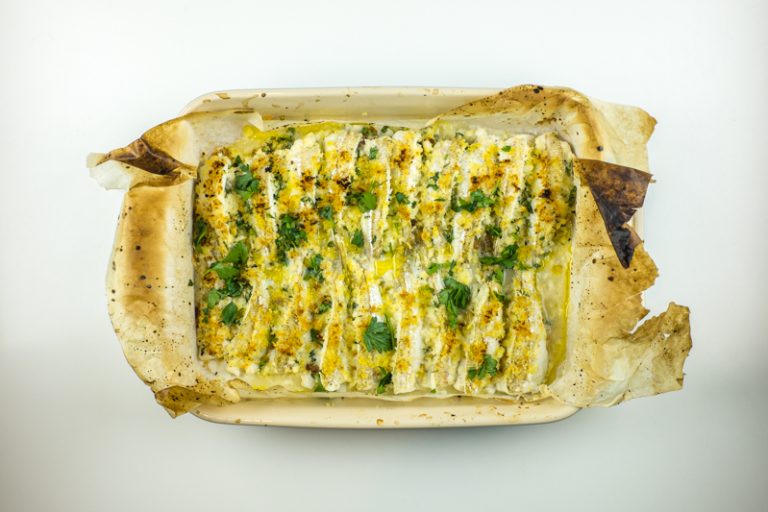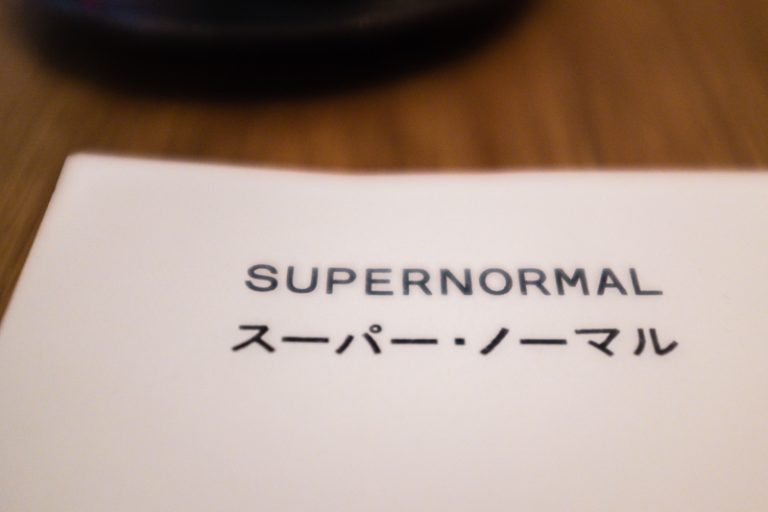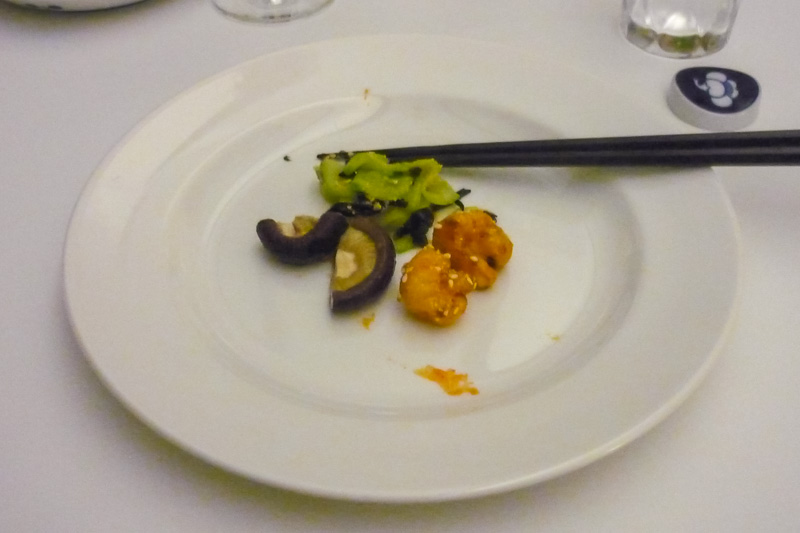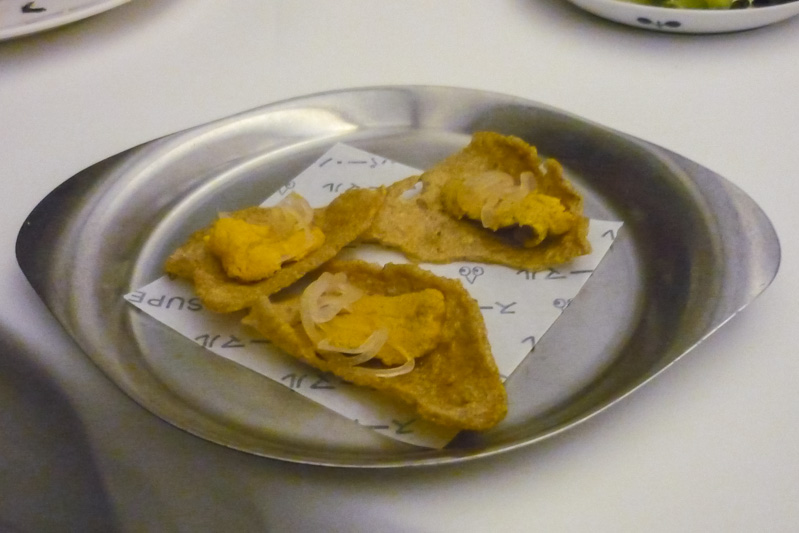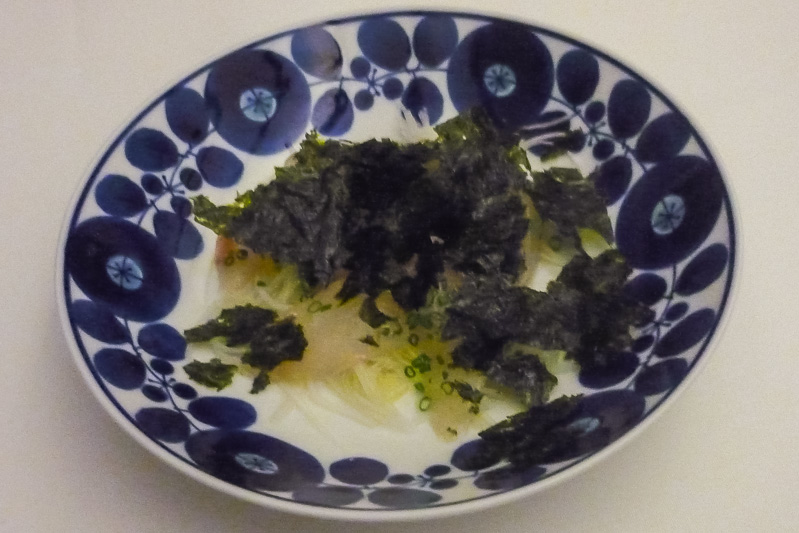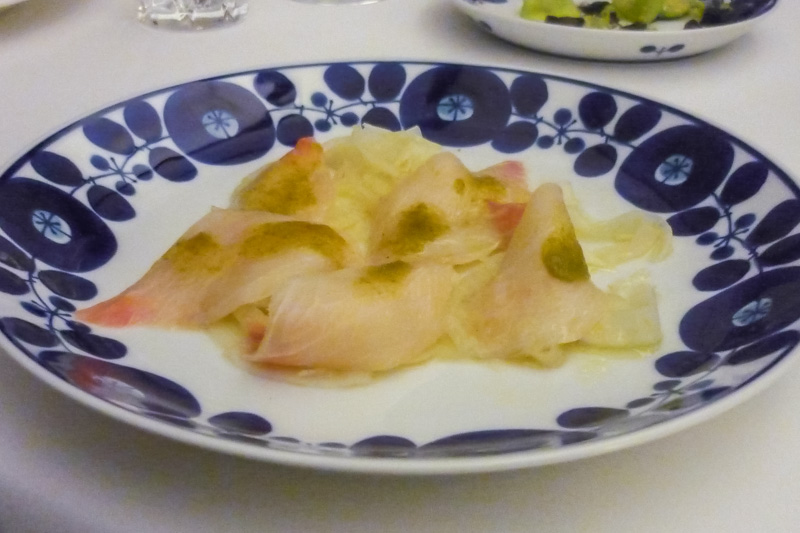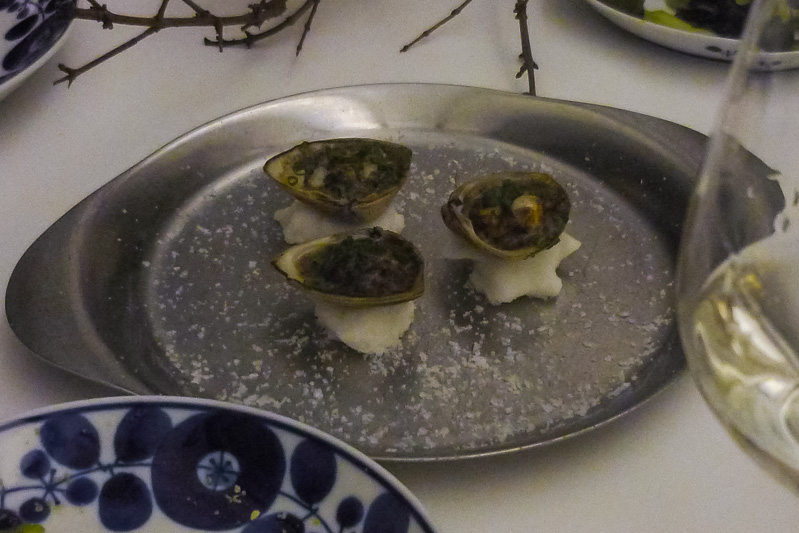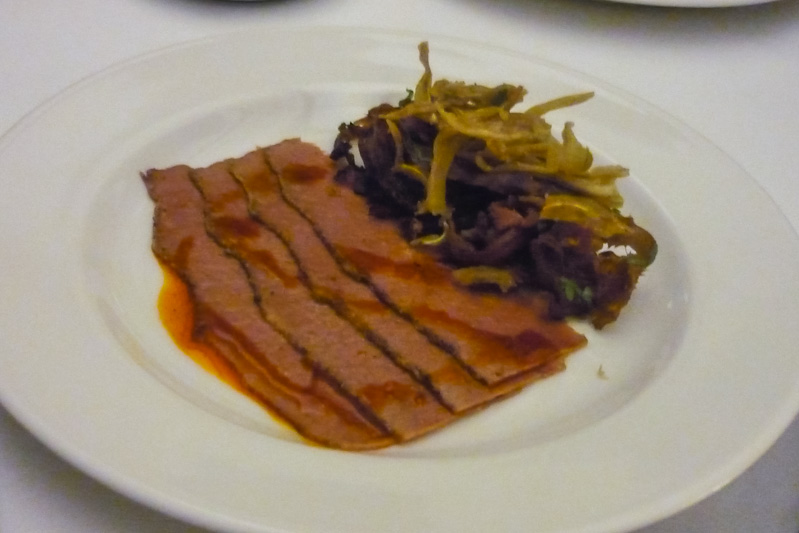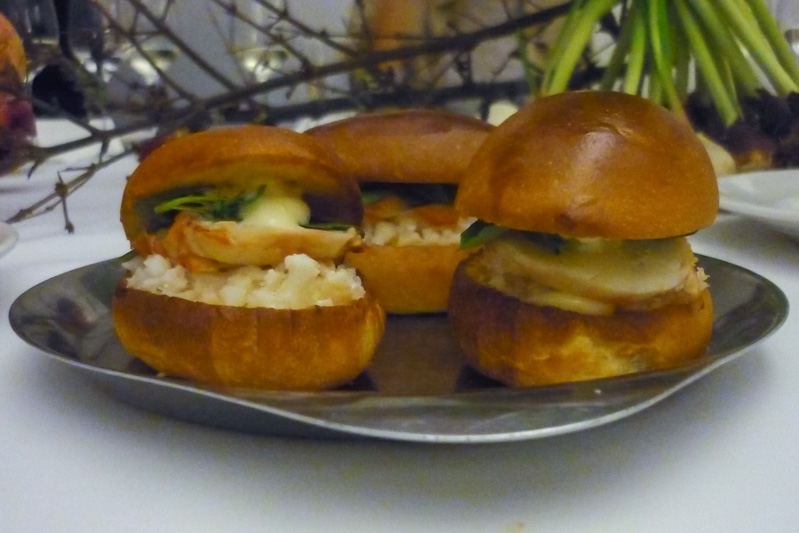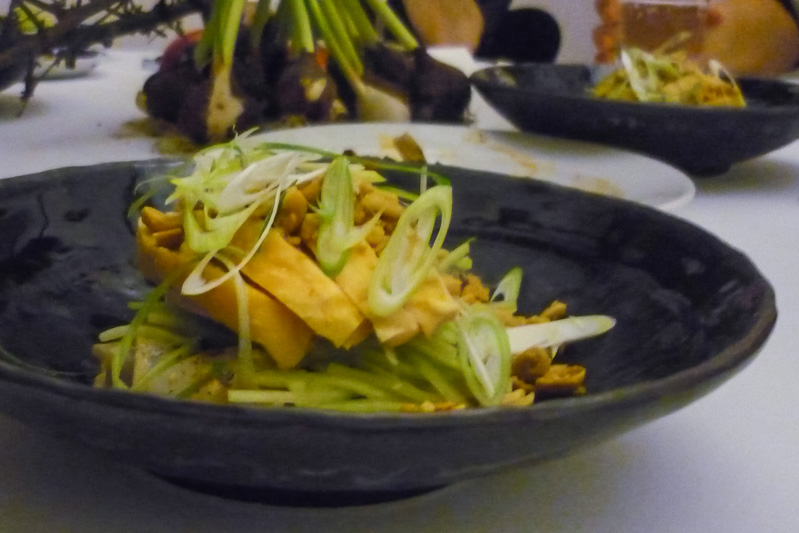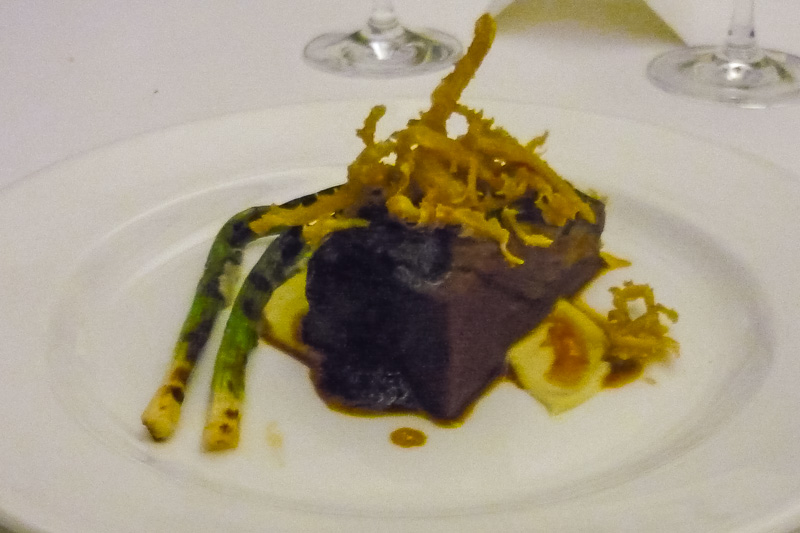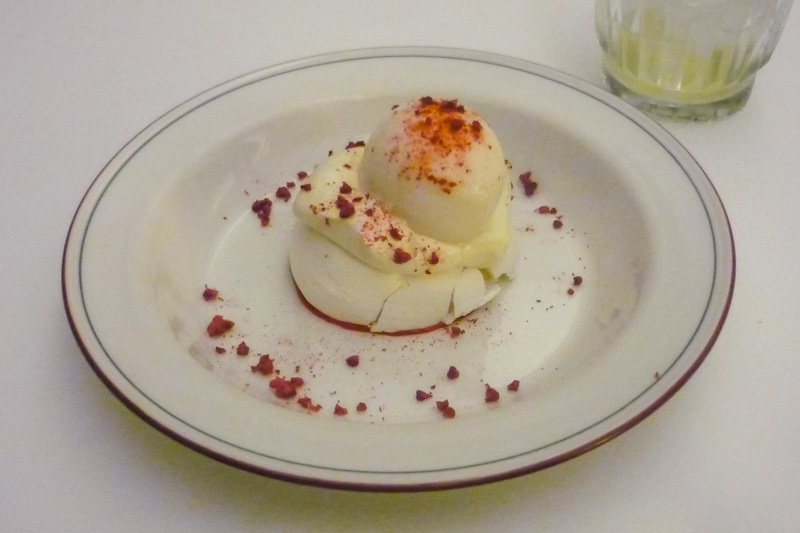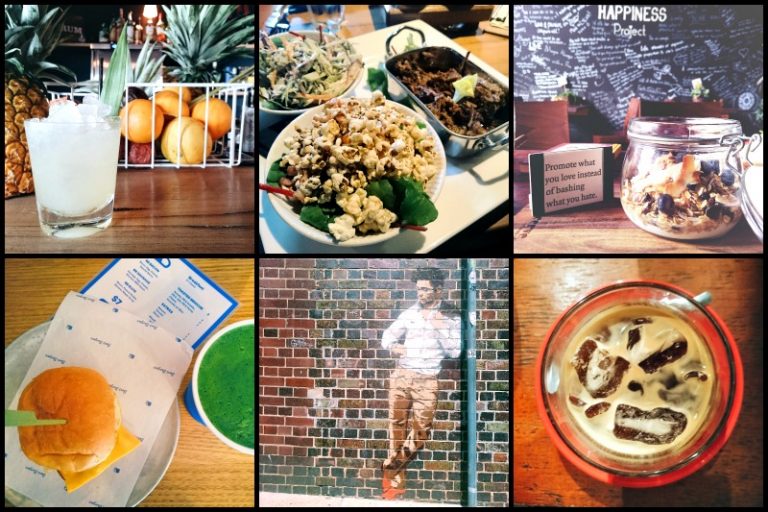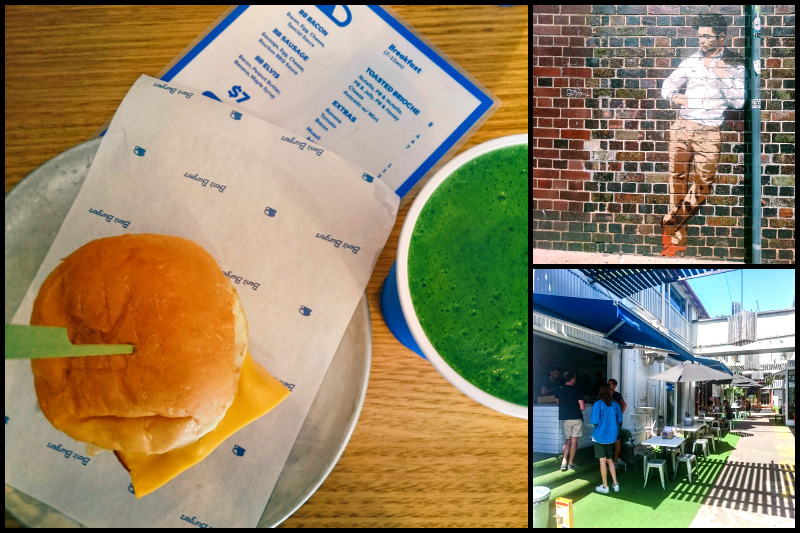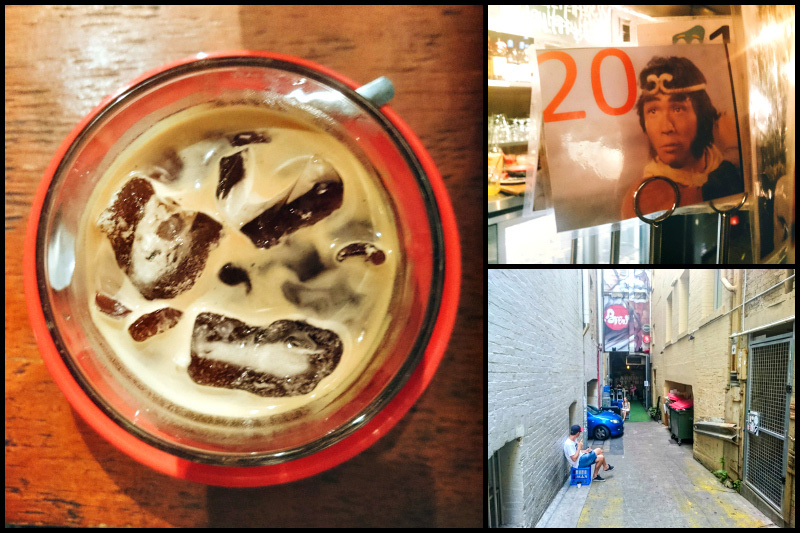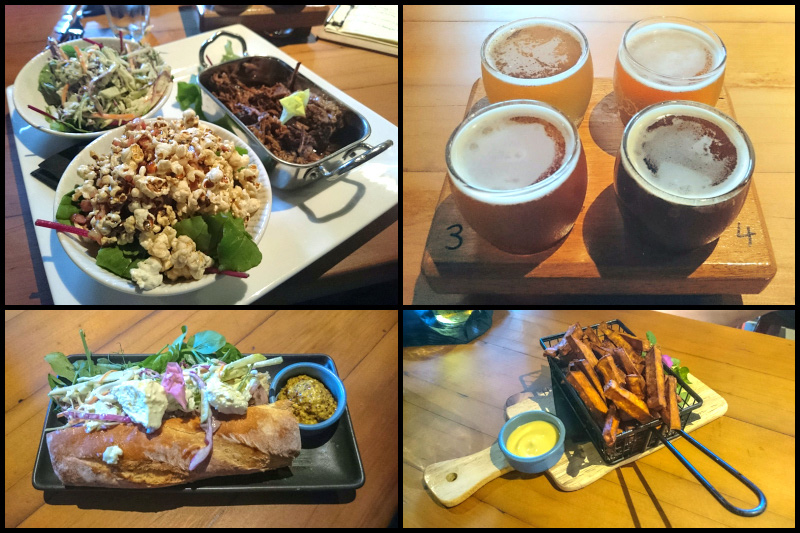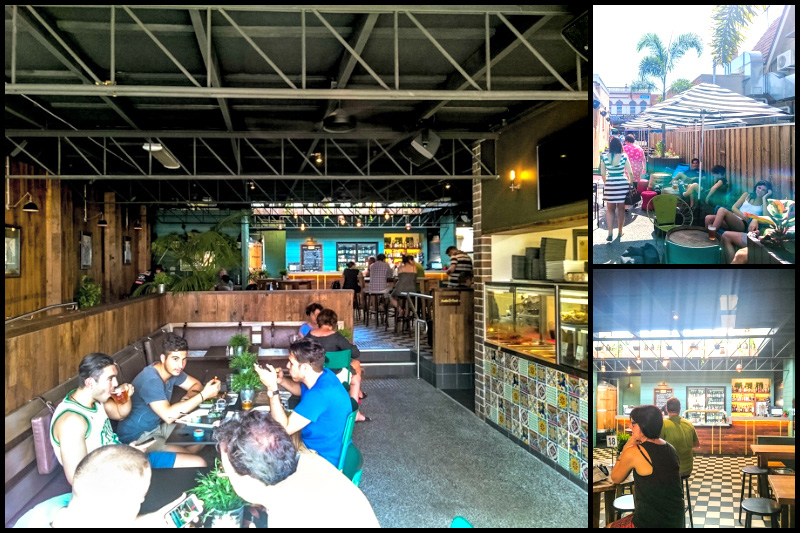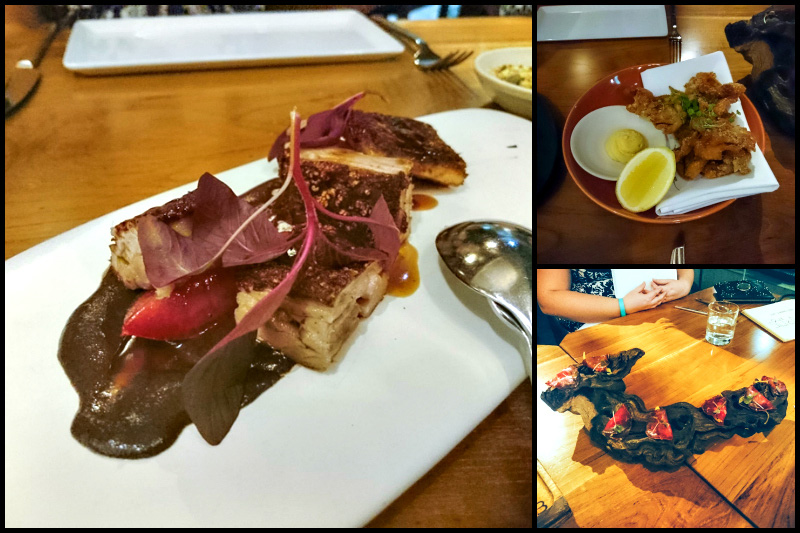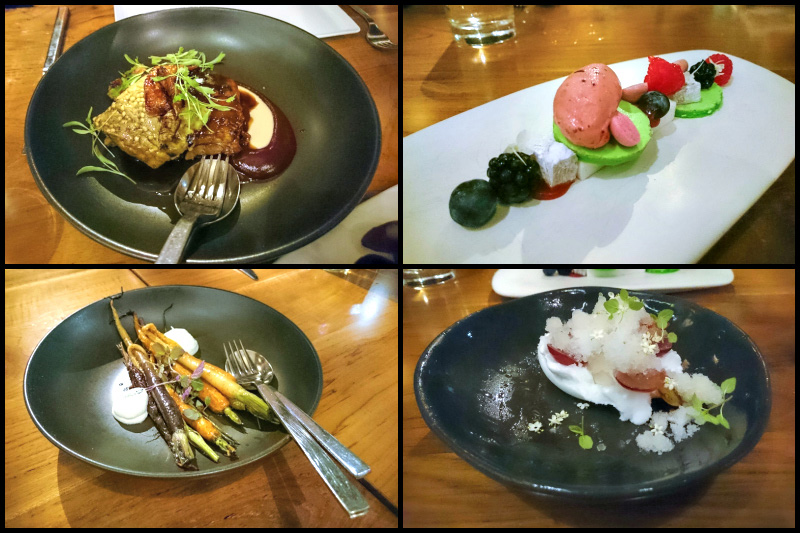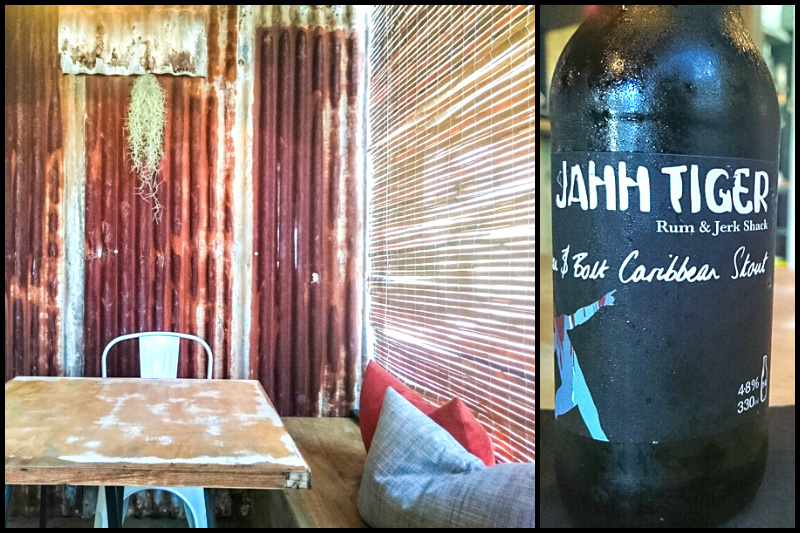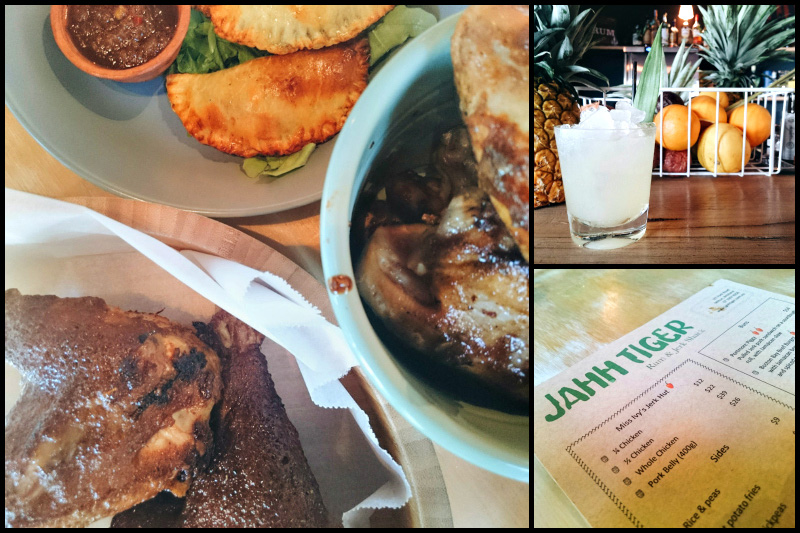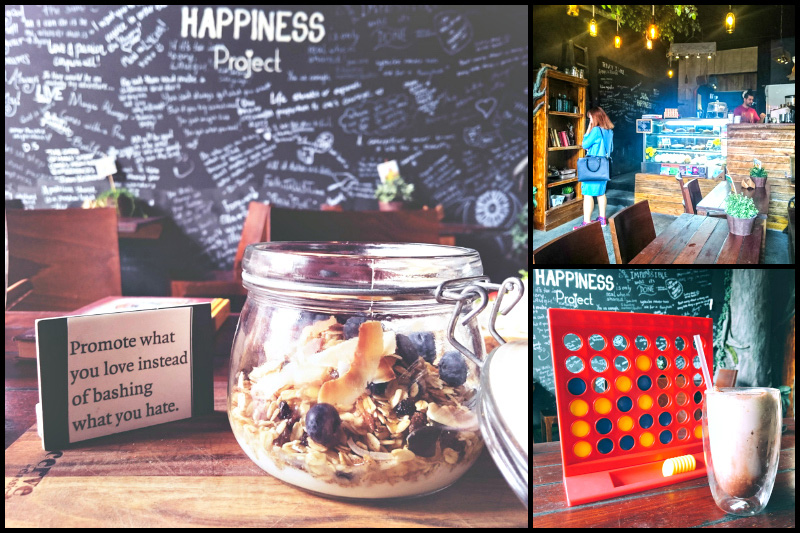Istanbul is a city that’s much larger than many realise. Spread out over 5,343 square kilometres, the former capital of Turkey (today the capital is Ankara) is home to 14.4 million people, making it the 5th largest city in the world. The city is one of the world’s true crossroads, finding itself in both Europe and Asia and has seen influences throughout its development from all over. As you’d expect, this all combines to make Istanbul one of the world’s truly great, diverse food cities.
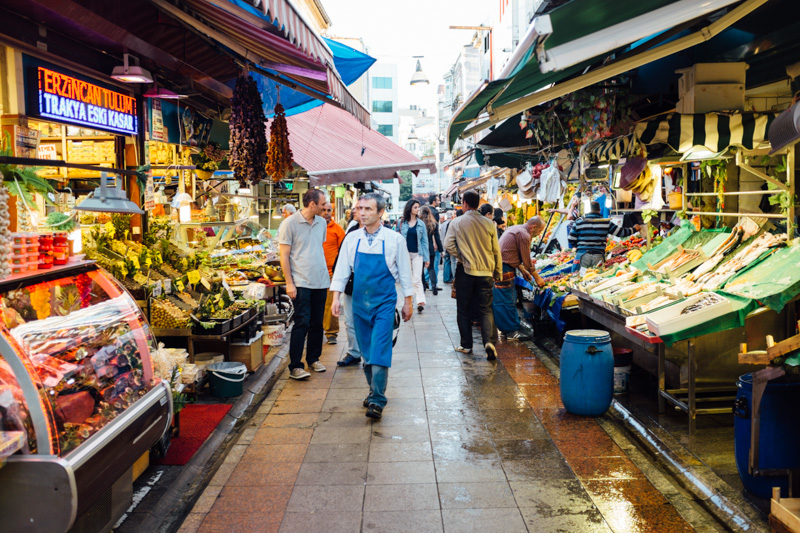
What though, do most people know about Turkish food? Ask the average person on the street outside of Turkey what they know about Turkish food and you won’t get too much of an answer beyond “kebabs”. Turkish coffee, baklava and Turkish delights may also come up in conversation but generally, people’s knowledge will be limited. We’ll admit that before we visited Turkey our knowledge on the diversity of food in Turkey was rather limited too.
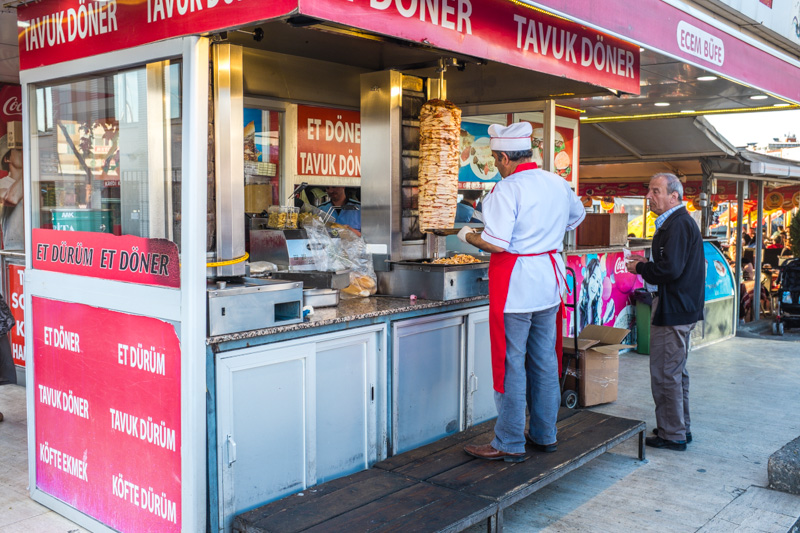
There’s a lot to cover in this city, but we’ll be keeping this Istanbul food guide focused on the Beyoğlu and Kadıköy districts, which is where most people tend to congregate and where a lot of Istanbul’s best restaurants, cafes, bars and pubs can be found. We’ve also included some great spots in the Fatih area – this is the part of Istanbul where most of the tourist sites are located and it can be hard to separate the quality from the rubbish. Whether it’s street food, a fancy meal or just a small snack that you’re looking for, you’ll be able to find it in Istanbul. A range of the types of food that can be found in Istanbul is listed, along with suggestions on where you can go to find some of the best examples of that food.
Also, we’d like to give a special thanks to Nick from Sharking For Chips & Drinks, for helping us find some of these great spots.
Kebab
Kebabs are unquestionably the Turkish food that most people are familiar with. The kebab however, is much more than the late night sliced meat wrapped in pita that most outside of Turkey associate with the term “kebab”. At its core, a kebab consists of pieces of meat, fish or vegetables that have been grilled on a skewer or spit. In Turkey there are at least 40 different types of kebab, with the following being the most common:
- Sish Kebab – Meat threaded on a skewer and grilled. Cubes of vegetables and/or fruit are usually used too.
- Döner Kebab – Sliced lamb, beef, or chicken, slowly roasted on a vertical rotating spit. Similar to Middle Eastern shawarma and Greek gyros. Döner kebab is most commonly served in a pita wrap with salad.
- Adana Kebab – a long, hand-minced meat kebab mounted on a wide iron skewer and grilled over charcoal.
It’s not hard to find a good kebab in Istanbul. The best advice that we can give you is to follow your nose. If you are walking down the street and you start to smell the scent of beautifully flame grilled meat, then start looking around. Usually you’ll find the source nearby, and if the place is good there will be locals eating there. Here are a few recommendations that particularly stood out for us.
Sehzade Cağ Kebap
This place specialises in cağ, a type of kebab that originated in Erzurum, a city in eastern Turkey. Slices of lamb (only lamb is used for cağ) and tail fat are marinated in yoghurt, black pepper and sliced onions overnight. They are then impaled on a spit and stacked thickly. The spit is then placed horizontally on a rotating mechanism and placed next to open flames, where it rotates and grills.
Cağ is not as common in Istanbul as other types of kebab, but it’s worth seeking out as it’s flavoursome and a lot more tender than many other types of kebab. One of the best places to find cağ in Istanbul is Sehzade Cağ Kebap.
The menu is small and very affordable – we recommend you order everything, as it all tastes great. Starters include a chilli paste, salad and a buffalo milk yoghurt.
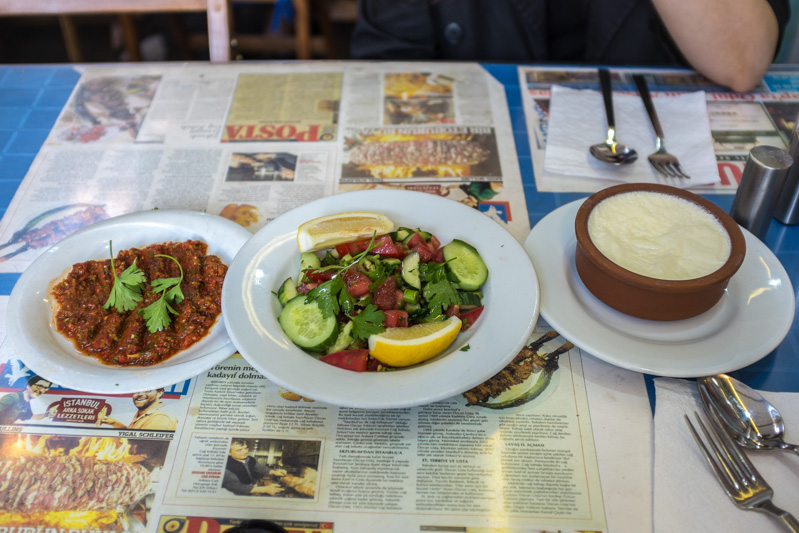
You can read more about tea in Turkey in the “Coffee & Tea” section below – it’s very common and you’ll find people drinking it everywhere here.
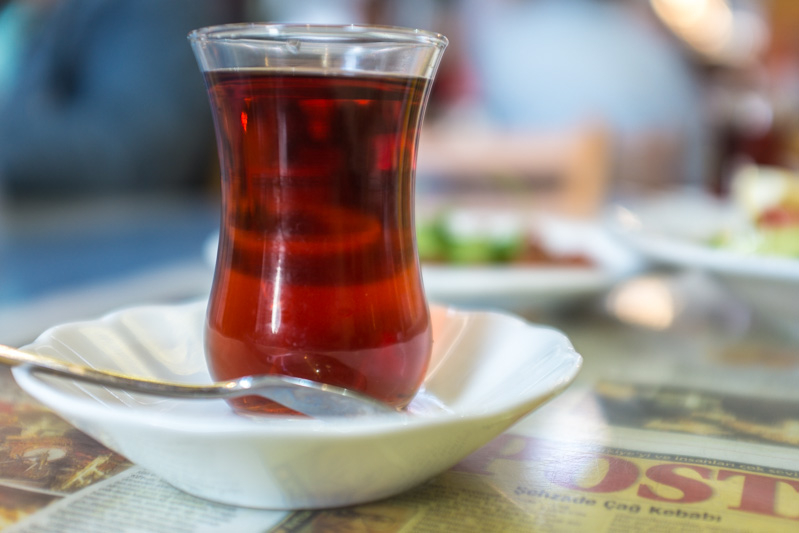
Cağ kebab on skewers.
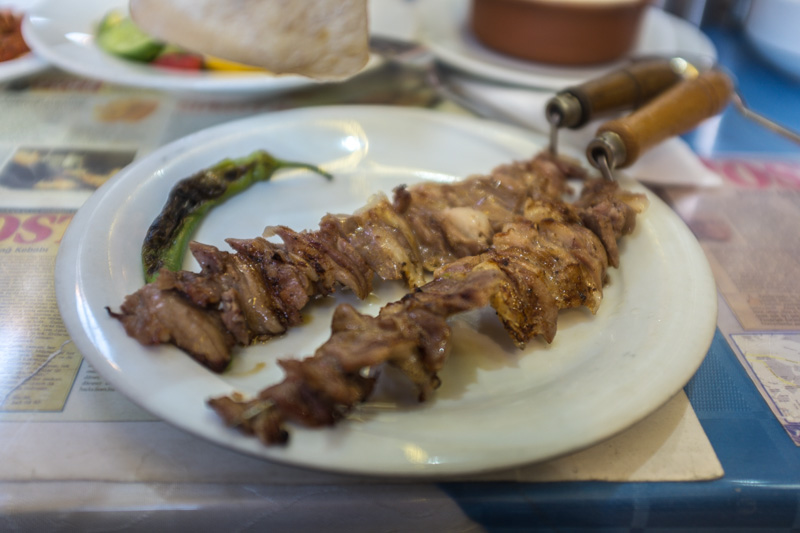
Cağ kebab with salad, wrapped in a thin pita.
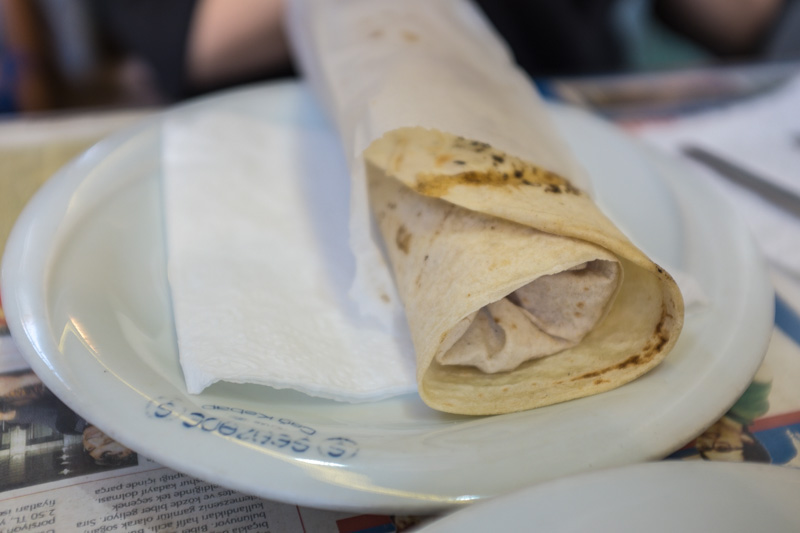
A traditional lentil soup (mercimek çorbası) with bread. This was surprisingly one of the highlights.
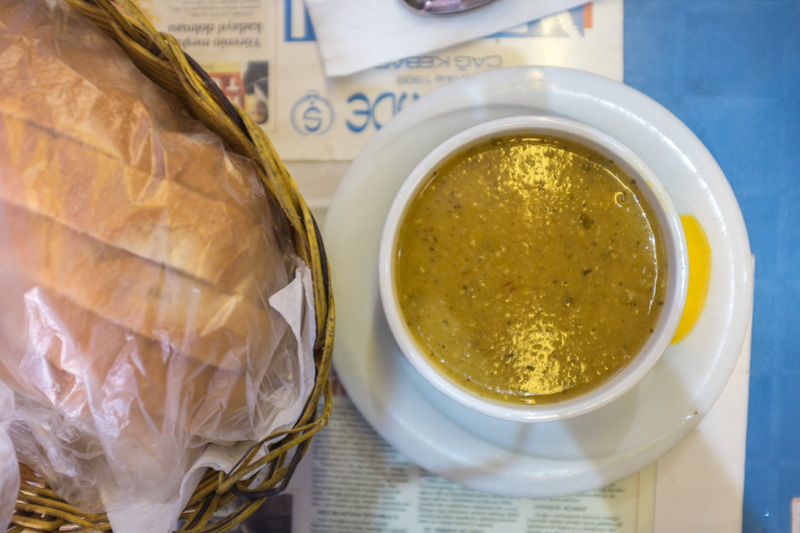
A dessert of tel kadayıf, which consists of long thin noodle shreds combined with syrup and nuts. Tasty, but very sweet.
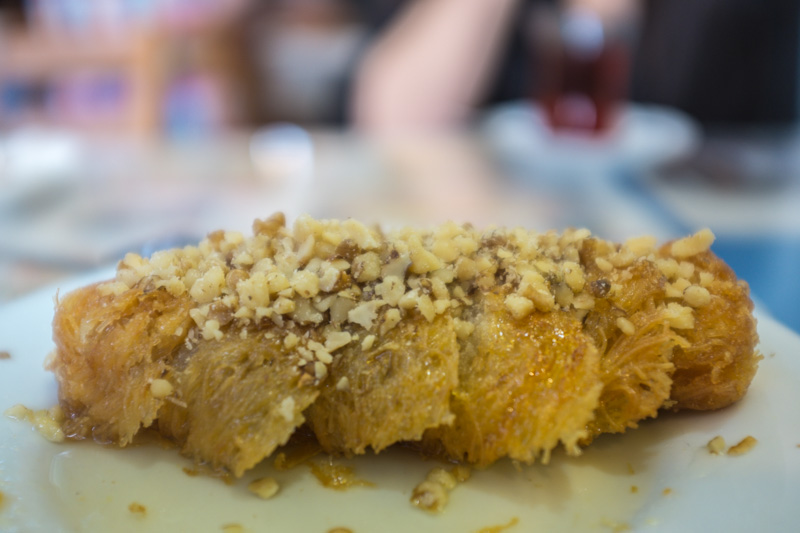
A Turkish coffee to finish the meal of course.
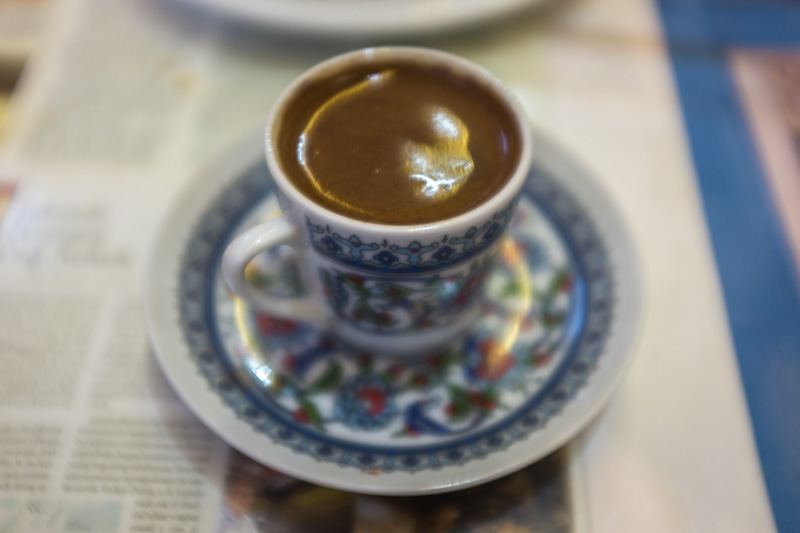
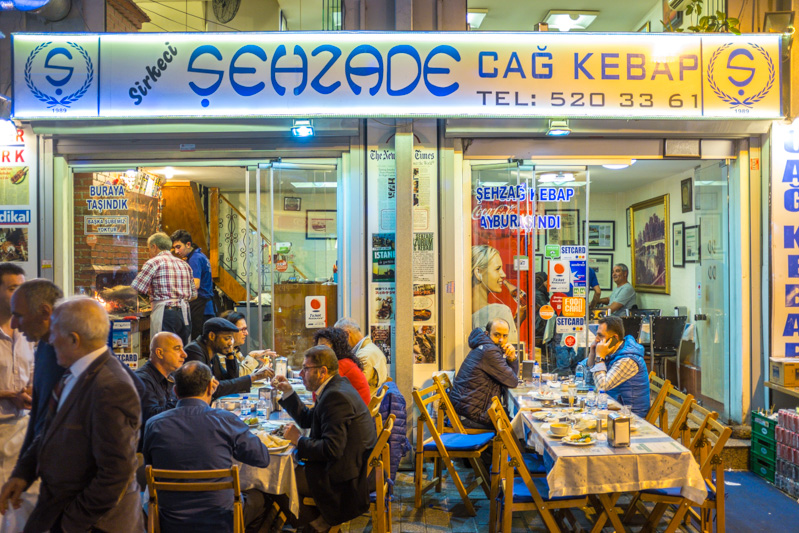
Sehzade Cağ Kebap
Hocapaşa Hamamı Sokak, No 6
Fatih, İstanbul

Kemer Dürüm Evi
This is the perfect example of why sometimes the best thing to do when hungry is follow your nose. Well I lie – we had actually eaten about half an hour prior and weren’t that hungry but when we smelt the grilled meat from the other end of the street we knew we had to find the source and try something. We followed our noses until we found Kemer Dürüm Evi and ordered what seemed to be popular amongst the locals we noticed ordering food, both to takeaway and eat in.
The meat in this dish had quite a spicy kick to it, and the bulgur pilavı (tomato and green pepper mixed with bulgur) was a surprisingly delicious addition. For only a few dollars (USD), it was an absolute bargain.
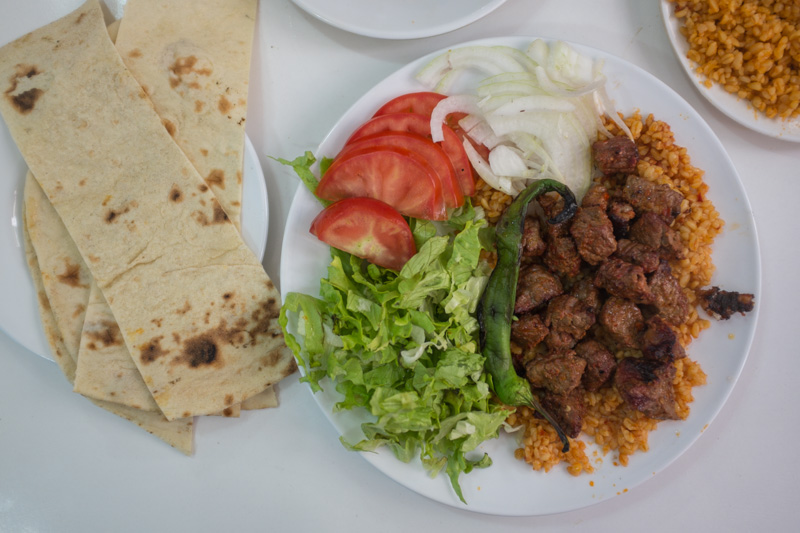
These kind of grills (Ocakbaşı) are very common in Istanbul. You’ll see the grill master busy grilling a variety of meats and vegetables on skewers. Ventilation shafts allow the smoke to escape outdoors – this is what we could smell from afar.
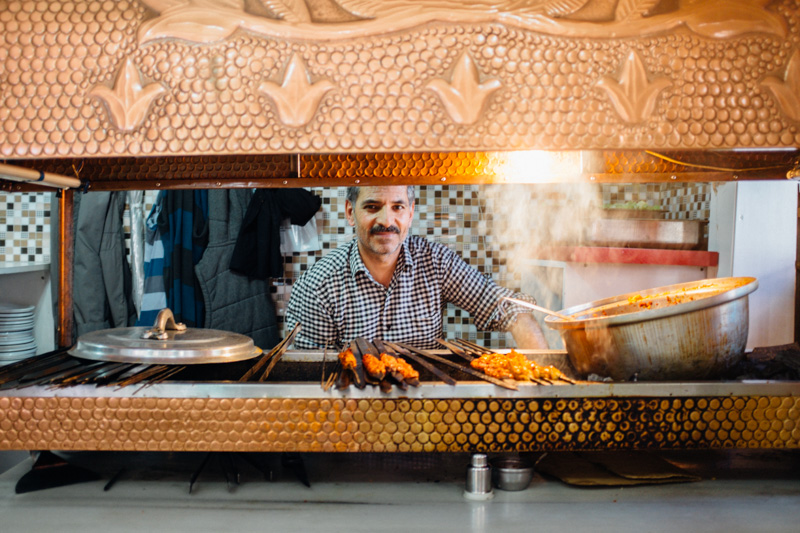
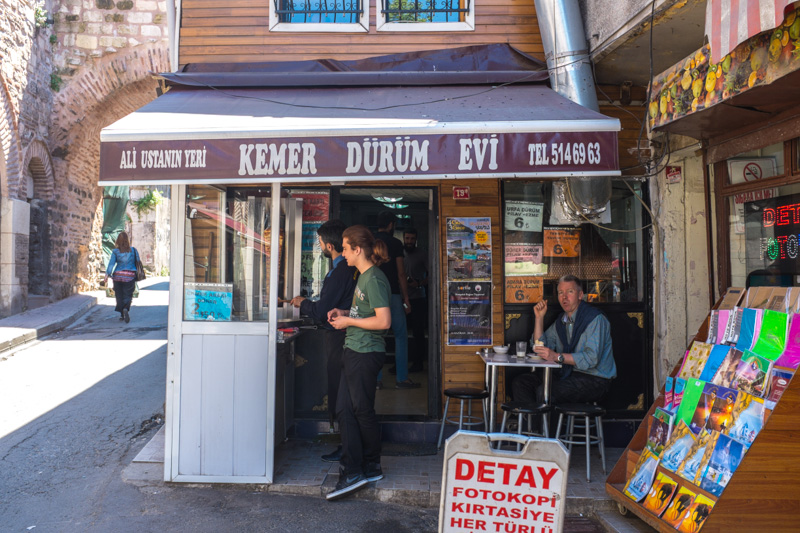
Kemer Dürüm Evi
Bozdoğan Kemeri Caddesi, No 63
Fatih, İstanbul

Dürümzadee
This place was on our list but unfortunately we never got the chance to visit. By all accounts it’s one of the best places to get a dürüm kebab in Istanbul. If you manage to visit, let us know what you thought in the comments below!
Also a word of warning. There are 2 places with this name, so make sure you go to the correct one as the other place doesn’t have a great reputation.
Dürümzade
Kamer Hatun Caddesi, No 16/A
Beyoğlu, İstanbul

Grilled Meat
Meat is an important part of the Turkish diet, however it wasn’t always this way. When the Greeks were in control of what is now Turkey, meat was not something you’d commonly find in Byzantium (the ancient Greek name for Istanbul). It was only when the Turkmen nomads took control that meat became an important part of Turkish cuisine.
The most common form of grilled meat in Turkey is of course, the already discussed kebab, however other kinds of grilled meats are also popular – lamb chops, kofte (meatballs – not always grilled), and even tartar (raw mince – and most definitely not grilled) are all easily found in Turkey.
Zübeyir Ocakbaşı
If you’re looking to try a range of some of the best grilled meats that Istanbul has to offer, then Zübeyir Ocakbaşı, which has been popular in this city ever since it opened in 2006, is a must. Ocakbaşı is the word for the long grill covered with a copper hood that you will see in many a restaurant in Turkey. This is where the meat in Turkey gets its amazing flavour – grilled over hot coals.
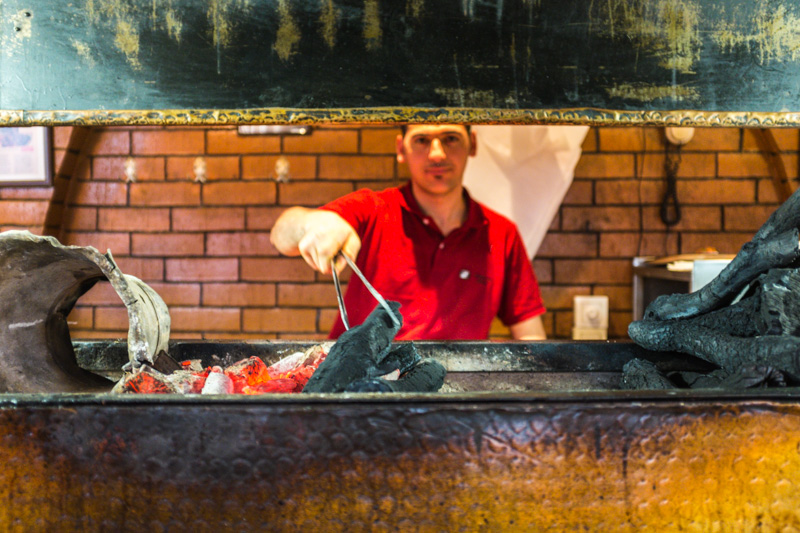
It’s not just about the meat here – the meze on offer is also great quality, especially the cacık (which is analogous to Greek tzatziki).

You can’t go wrong with any of the meats on offer, but we’d highly recommend you get the lamb chops in amongst your selection – they are delectable. Another must do is to wrap a few cubes of kebab meat with some grilled tomato and green pepper in the supplied flat bread.
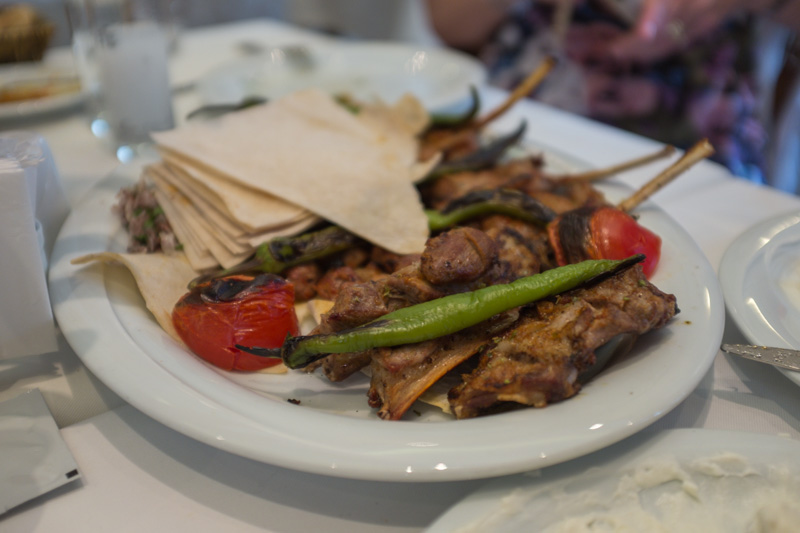
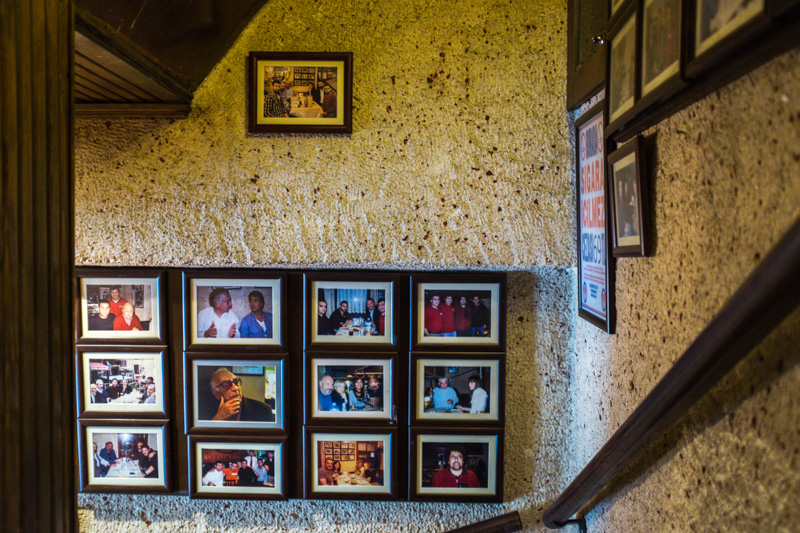
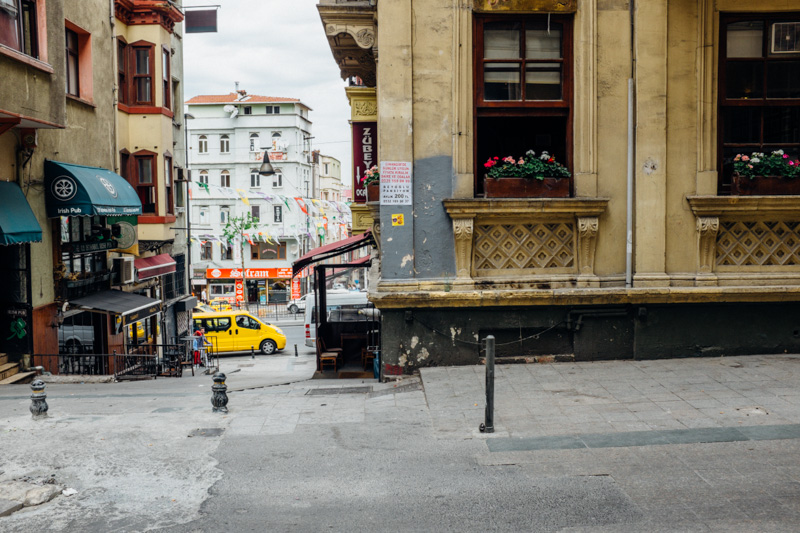
You simply must visit Zübeyir Ocakbaşı if you’re in Istanbul as it really is one of the best places for grilled meat in the city.
Zübeyir Ocakbaşı
Bekar Sokak, No 28
Beyoğlu, İstanbul

Antiochia Concept
Antiochia Concept specialises in cuisine from Antakya, in Turkey’s Hatay Province. The food is spicier than in other parts of Turkey and the meze are generally sweeter.
I questioned whether or not I should include Antiochia Concept in this list, but decided to for one simple reason: The food that we ate here was really good. The lamb in particular was some of the best we tried in Istanbul – nicely charred on the outside and beautifully tender, cooked medium on the inside. The wrapped beef kebabs that we ate were also very tasty and full of flavour, with a great interplay between sweet and spicy.
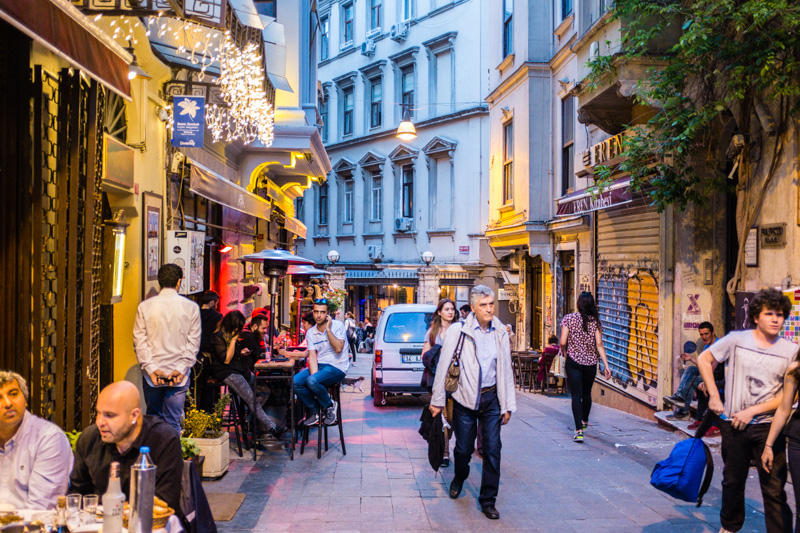
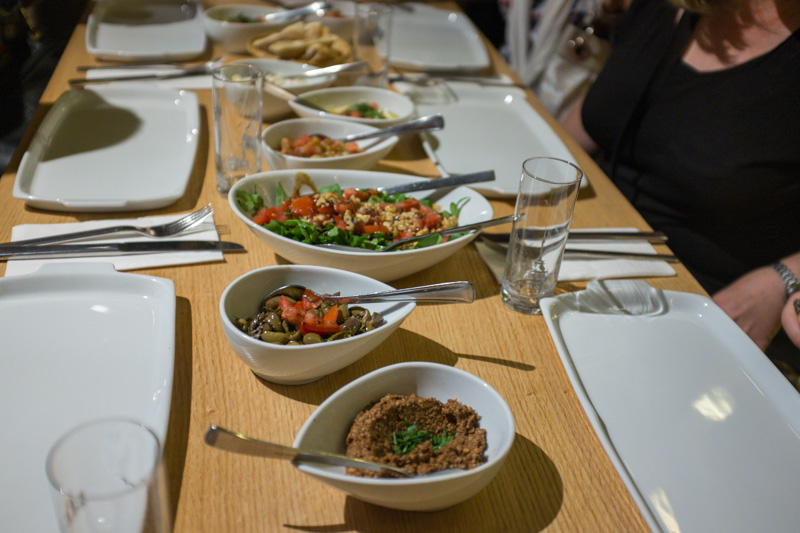
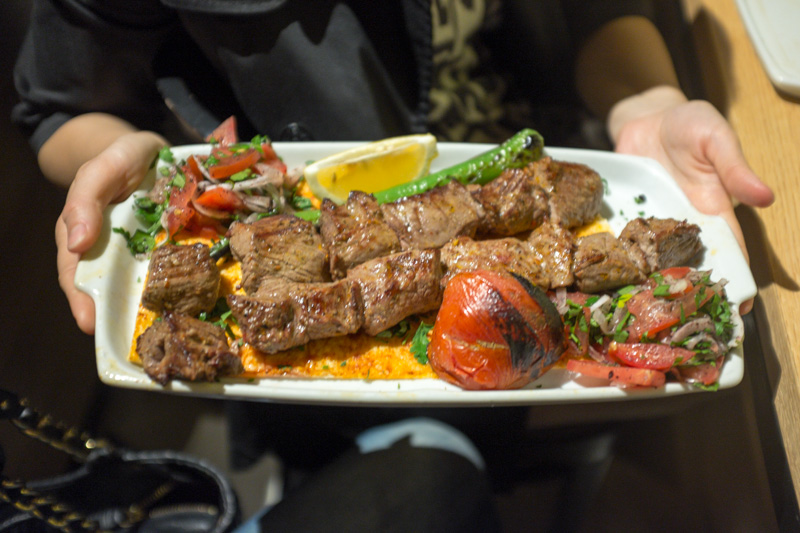
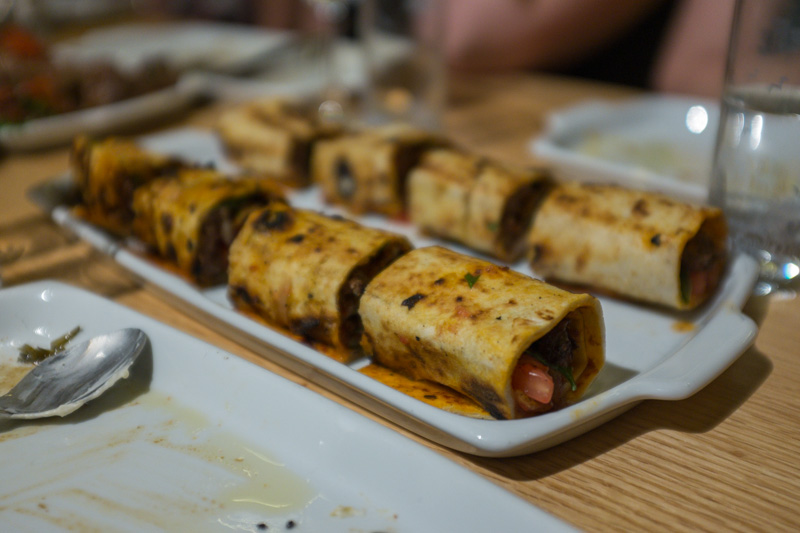
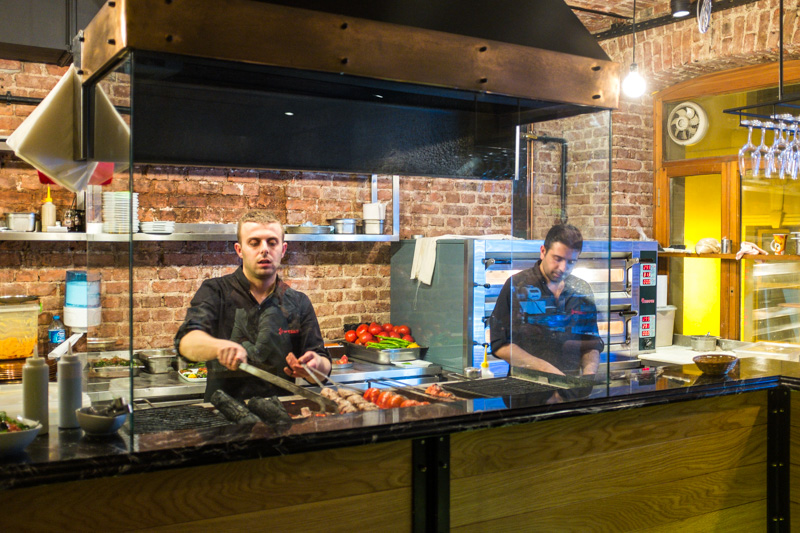
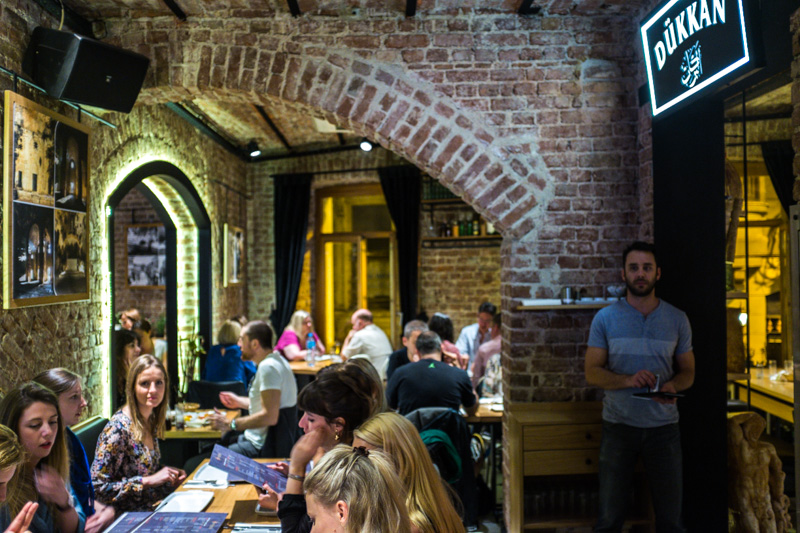
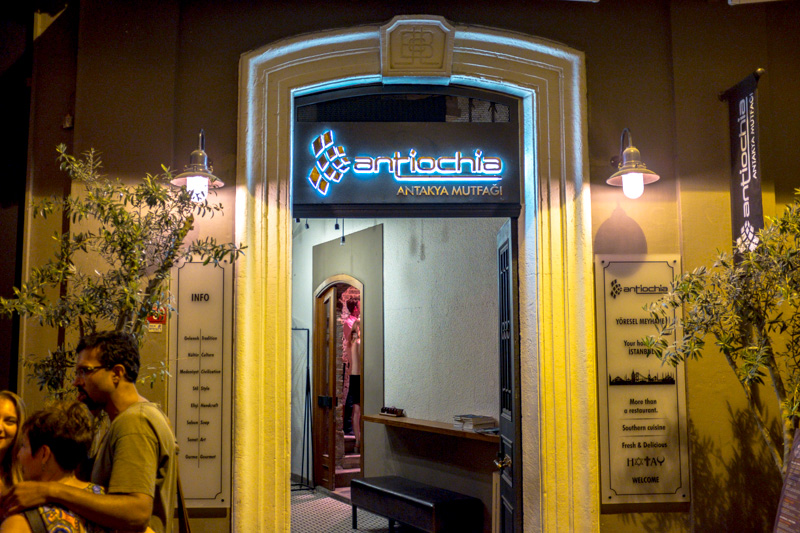
If the food was so good, why, did I question Antiochia Concept’s inclusion in this list? Well reports indicate that the food at this restaurant which is popular with both locals and tourists can be quite inconsistent. We might have had an excellent meal (although admittedly the service was slow), but I’ve read stories about people who have had some pretty bad experiences both food and service wise at this place. At the end of the day, I’ll leave the choice up to you.
Antiochia Concept
Minare Sokak, No 21/A
Beyoğlu, İstanbul

Breakfast
Breakfast is an important meal in Turkey and the full Turkish breakfast spread is one of the best breakfasts we’ve seen anywhere in the world. Certain aspects of the Turkish breakfast vary from region to region but there’s a lot that’s consistent. Tea, bread, white cheese, old cheese (kaşar peyniri), black and/or green olives (zeytin), butter, honey, jam, an omlette or boiled eggs (yumurta), sliced tomatoes and/or cucumbers are all staples.
Van Kahvati Evi
Van Kahvati Evi has a reputation for serving up one of the best Turkish breakfasts in town and when we ordered the traditional breakfast spread from this popular cafe we could see why. All of the essential components were present and everything tasted great. The addition of halva and a range of spreads (including Nutella, which might not be traditional but seems to have become the world’s de-facto favourite spread) served to sweeten the deal. this impressive serving was actually only a serving for one, but it easily fed 2 people.
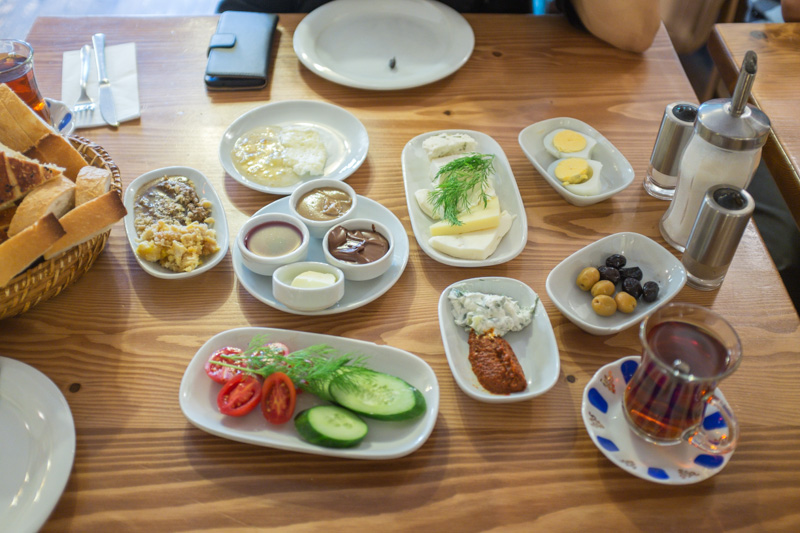
We also ordered some gozleme, not because the food above wasn’t enough, but because we wanted to try some. We got the spinach version which was very tasty – the bread was quite light and the dish wasn’t oily, as can sometimes be the case with gozleme.
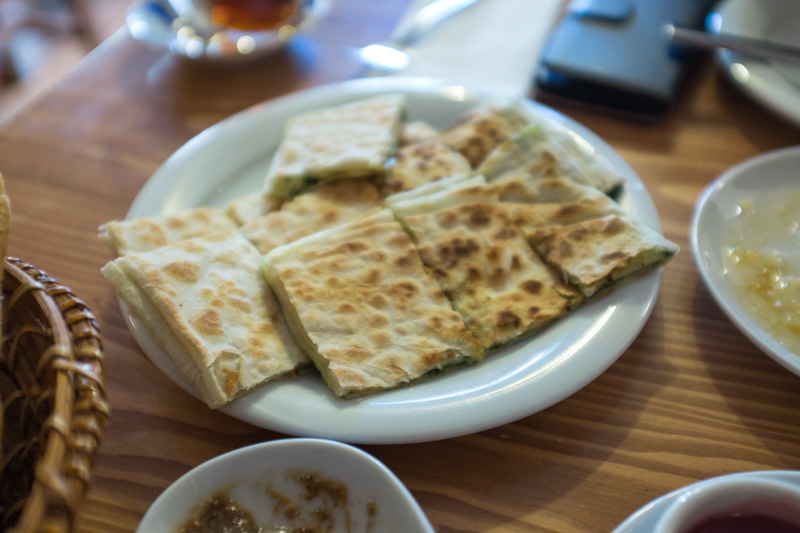
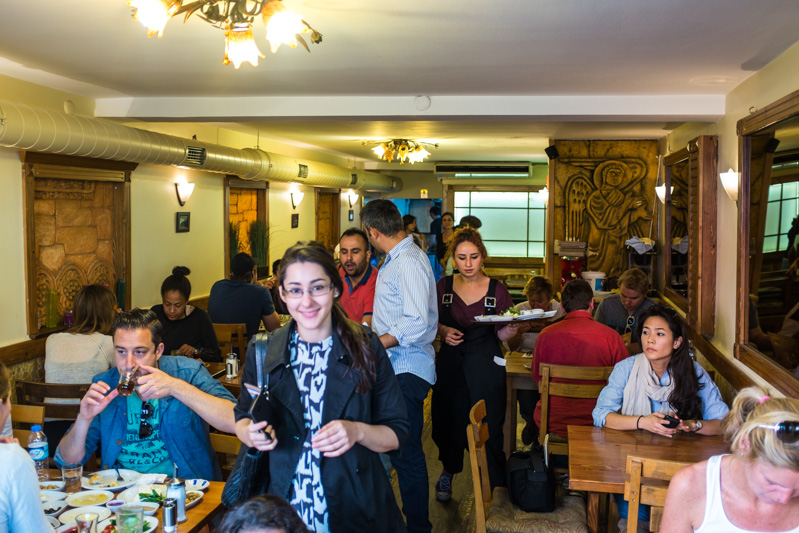
Along with breakfast, Van Kahvati Evi operates as most cafes do and serves decent lunch and cafe food too, but you don’t have to worry about rushing here for breakfast, as it’s served all day.

Van Kahvati Evi
Defterdar Yokuşu, No 52
Beyoğlu, İstanbul

Cuma
Cuma is another place that serves up a top quality Turkish breakfast and a variety of other impressive dishes throughout the day (just check out the menu on their website – impressive!). Unfortunately we ran out of time to try it but we thought we’d let you know as we’ve only heard good things.
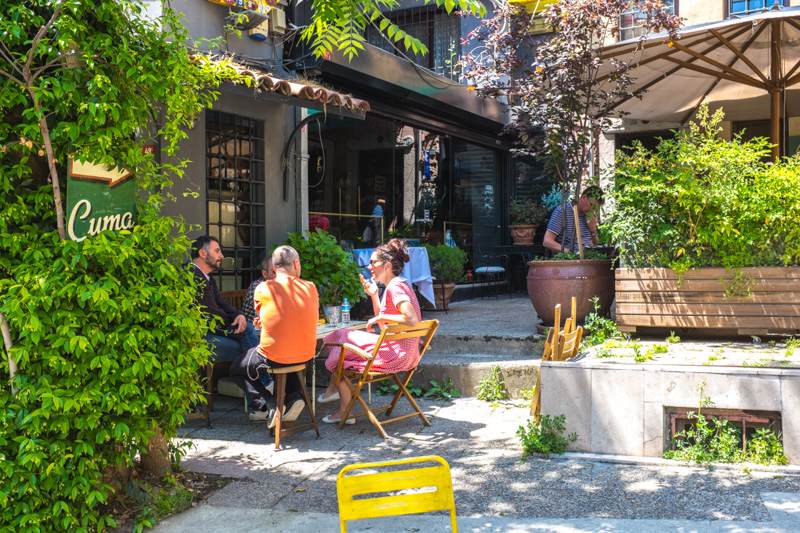
Cuma
Çukurucuma Caddesi, No 53/A
Beyoğlu, İstanbul

Baklava
If there’s a Turkish food other than kebabs that people outside of Turkey have heard about this is it. Baklava is made of layers of filo pastry filled with chopped nuts, sweetened and held together with syrup or honey. It’s popular in Turkey, Greece and throughout the Middle East (basically anywhere that was a part of the Ottoman Empire) with the Turkish version usually containing pistachios, walnuts or almonds.
Sweet shops are easy to find all over Istanbul, and if a place sells baklava you’ll usually notice it on display in the window.
Karaköy Güllüoğlu
Karaköy Güllüoğlu is one of the most famous places to get baklava in Istanbul – it’s been selling its creations since 1820! Thankfully, it lives up to its reputation, with the baklava not being overly syrupy and the pasty layers being nicely defined and crispy. There are a range of types to choose from, with different nuts and syrups being used. I went for the pistachio, walnut and chocolate baklavas. The best were the walnut and the chocolate, which had a deep real cocoa flavour to it.
Along with baklava, a range of other desserts such as Turkish delight, cakes and flans are sold here but the baklava is what it’s all about.
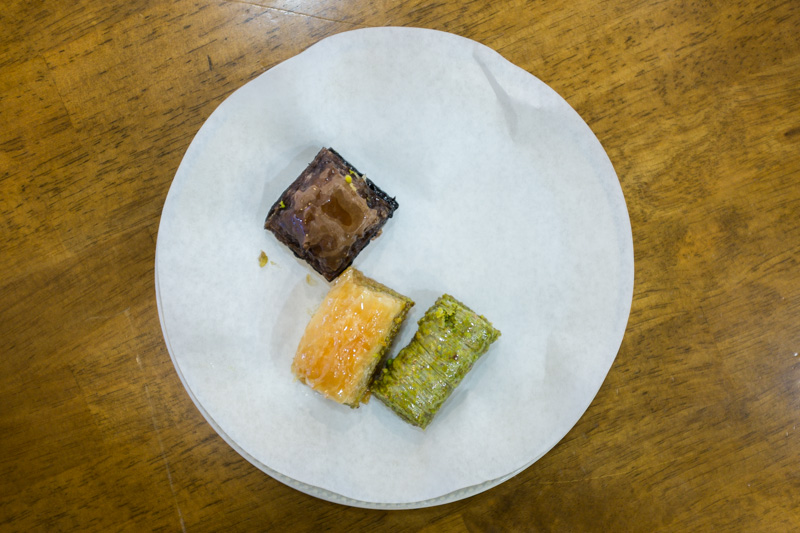
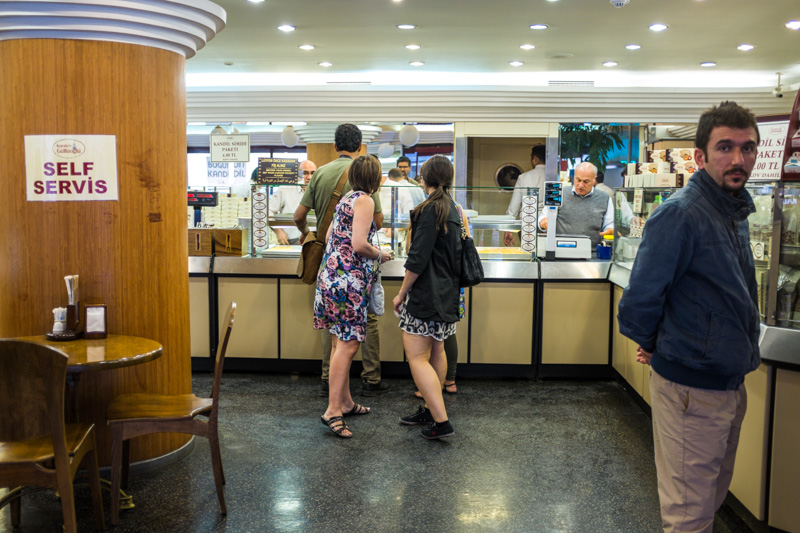
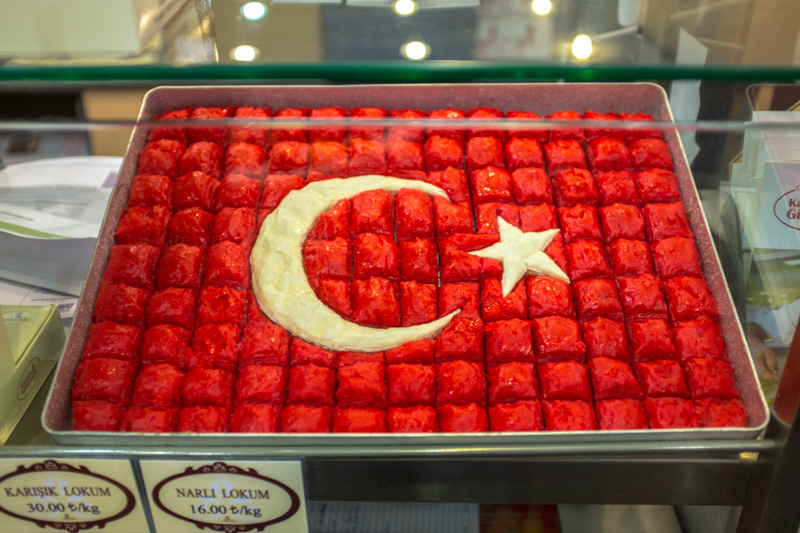
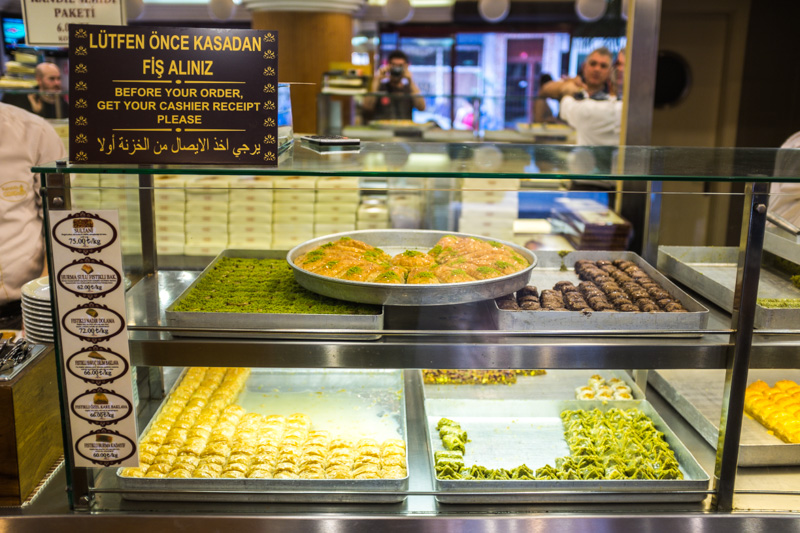
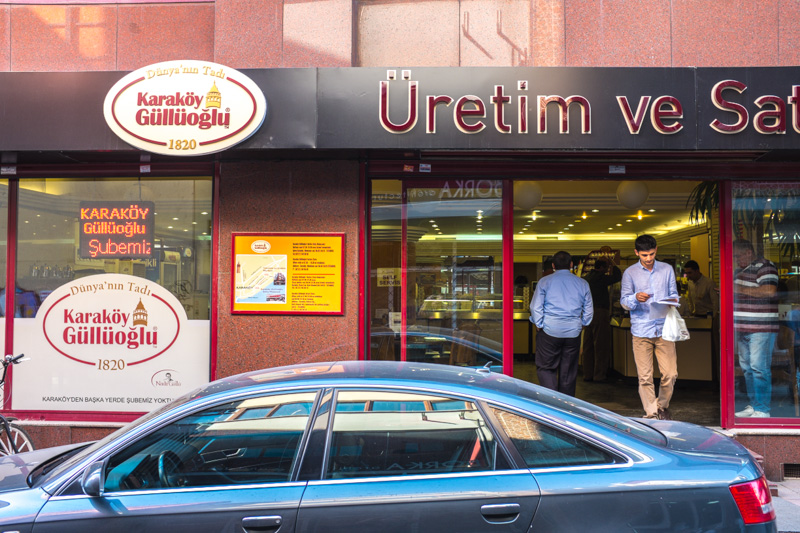
Karaköy Güllüoğlu
Mumhane Caddesi, No 171
Beyoğlu, İstanbul

Gaziantepli Baklavacı Bilgeoğlu
Gaziantepli is just as famous as Karaköy, with the secret (well not really a secret) behind its famously buttery baklava being the use of clarified butter (which you can buy on its own to take home and cook with). We didn’t get the chance to visit but by all accounts the baklava here is heavenly, with the pistachio version being particularly well regarded.
Gaziantepli Baklavacı Bilgeoğlu
Nailbey Sokak, No 1/B
Kadıköy, İstanbul

Lokum (Turkish Delight)
At their most basic, lokum are a starch and sugar gel, flavoured with rose water, mastic or lemon water. They are often cubed and coated with icing sugar. They have a solid, dense jelly-like texture and are very tasty. Sometimes nuts are used as well although it’s not a necessity. As with Baklava, lokum are plentiful throughout Istanbul and can be seen gracing the displays of many a sweet and convenience store. It’s actually pretty hard to find a bad lokum as it’s such a simple delicacy.
Altan Şekerleme
We didn’t have the chance to get to Altan Şekerleme but for more varieties and flavours than you’re ever likely to need, this is supposed to be the place to go. It’s a sweet shop that’s been operating since 1865 which sells a variety of sweets. Along with lokum, they are also known for their Akide, which is a type of hard candy.
Altan Şekerleme
Kıble Çeşme Caddesi, No 68
Eminönü, Fatih, İstanbul

Coffee & Tea
Mention Turkey and coffee to most and for good reason, minds will instantly go towards the traditional Turkish coffee. The old school Turkish coffee is hugely popular in Turkey and can be found at basically any place that sells food or drink. It’s prepared by boiling finely ground (beans are ground as fine as is possible) roasted coffee beans (any beans will do) in a pot over a stove top, with or without sugar. The coffee is served in a small cup with the grounds, which are allowed to settle. It’s a thick and intense coffee with a very unique flavour.
We had a lot of Turkish coffees while in Istanbul and all of them were great. What I want to focus on below are the new generation of coffee shops that are embracing a variety of coffee styles from around the world. Third wave coffee has hit Istanbul, and no matter how you like your coffee, you’ll be able to find a place that does what you want.
Kronotrop
If you haven’t heard the term “third wave coffee” before it’s a movement that focuses on attaining the highest quality of coffee craftsmanship possible. From the growing of the beans, sustainability of farms, roasting of the beans to the final cup of coffee, all aspects of the process are focused on. Kronotrop is one of the best examples of a third wave coffee shop in Istanbul, with a range of single origins and blends from around the world available to have brewed using almost any method you can think of. Turkish coffee, espresso, cold drip, filter – it’s all here. The coffee is, as one would expect, outstanding.

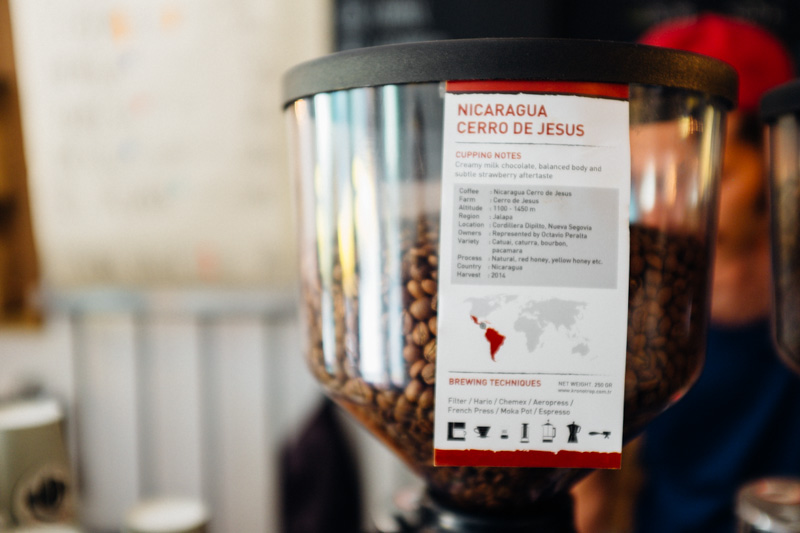
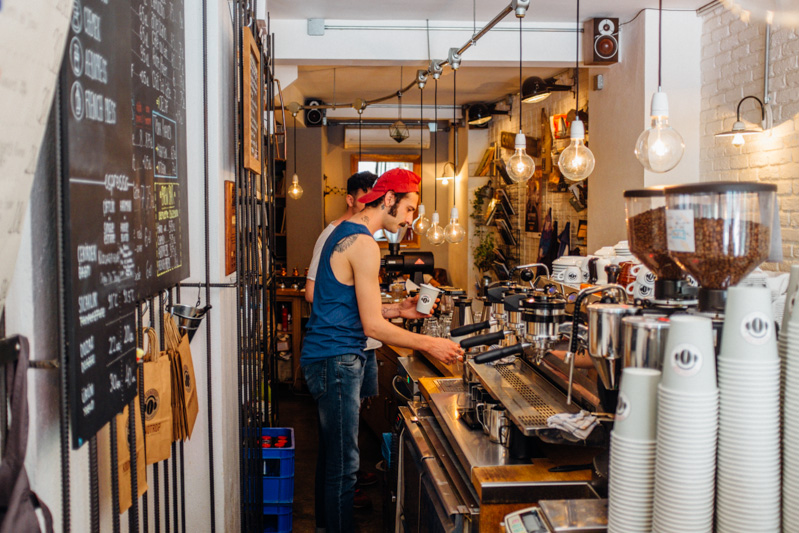
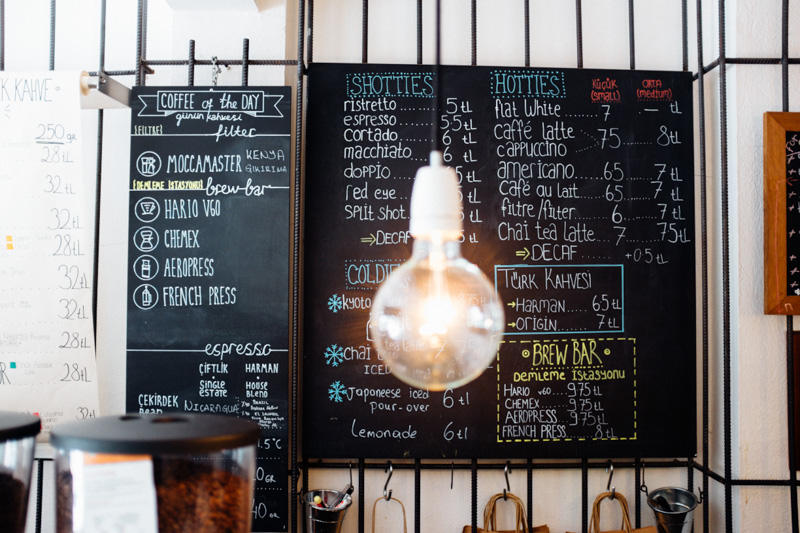
Turkish coffee can be made using any beans that one chooses, but when you come to a place like Kronotrop and they’re using the best beans that there are in the world, you notice the step up in quality compared to the rest. Along with coffee, a small selection of cakes and snacks is offered to enjoy in this chilled out, funky space.
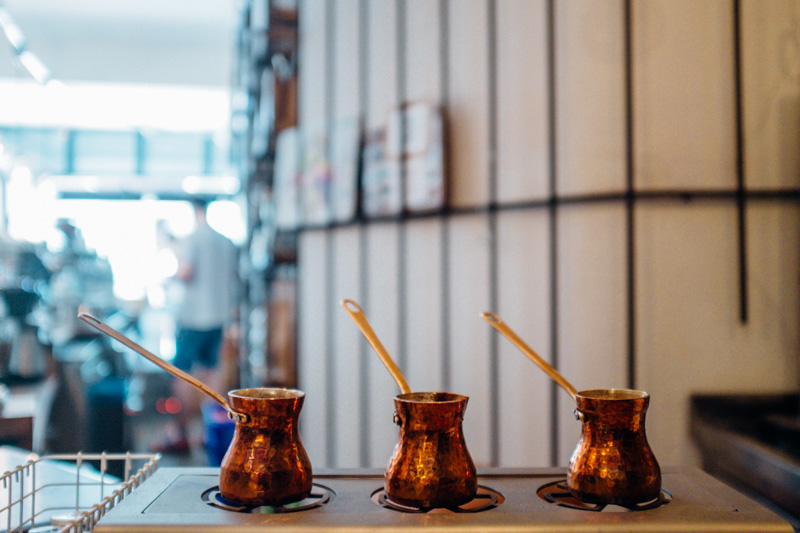
Kronotrop
Firuzağa Cami Sokak, No 2/B
Beyoğlu, İstanbul

Holy Coffee
Holy coffee is another third wave coffee shop in a part of Istanbul that’s full of quirky antique shops. The coffee is very good and the fit out is very homely. Along with coffee, there’s a range of biscuits, cakes, sandwiches, soups and salads on offer to satisfy those who are feeling peckish.
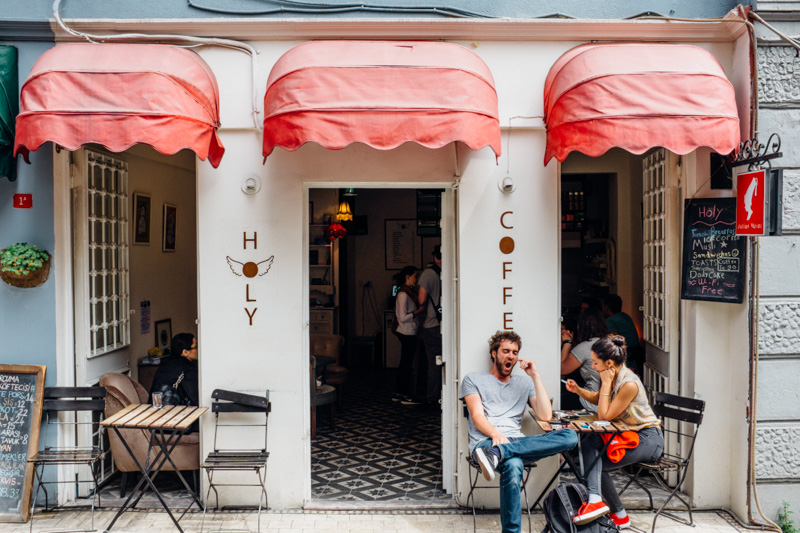
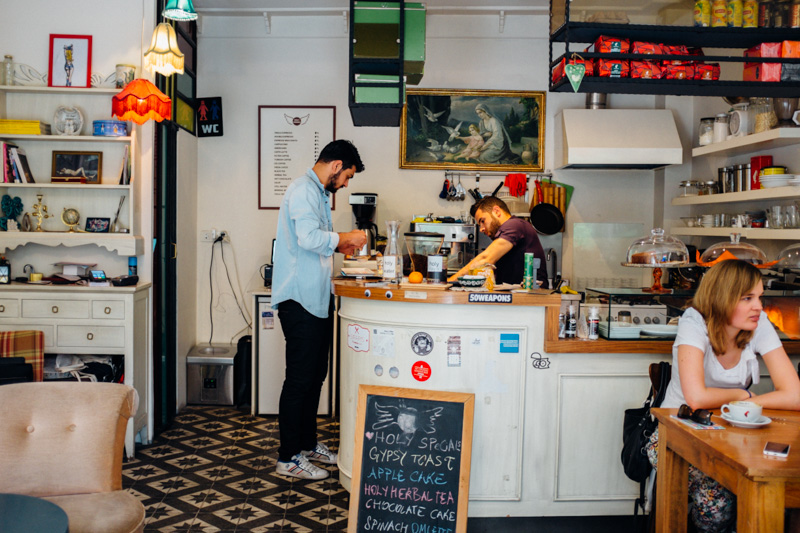
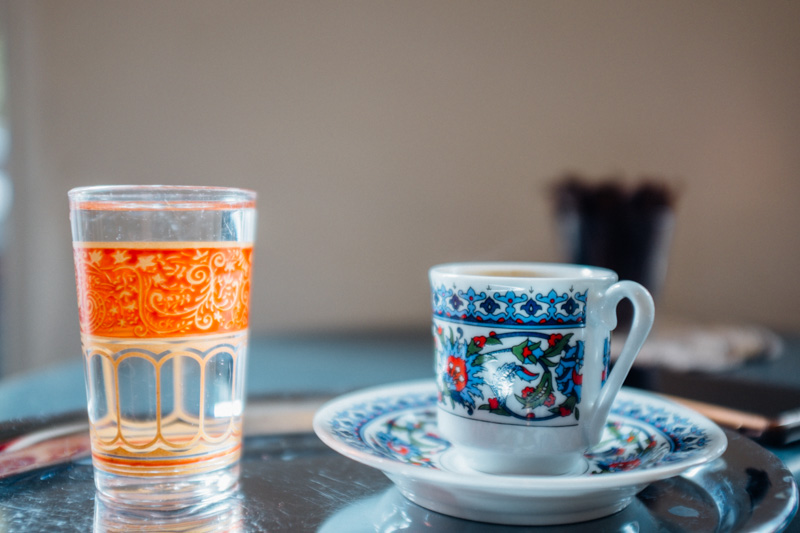
Holy Coffee
Hacıoğlu Sokak, No 1/B
Beyoğlu, İstanbul

Geyik
Yet another excellent third wave coffee shop in Istanbul is Geyik. Not only do they serve an impressive range of coffee styles using excellent beans, but the place also operates as a cocktail bar at night. It’s become quite popular since opening in 2014 and for good reason – the service is great and the coffee (and by all accounts the cocktails too) is top notch. Serkan İpekli, the co-owner and barista was the 2013 Turkish Barista Champion so you know he knows his stuff.
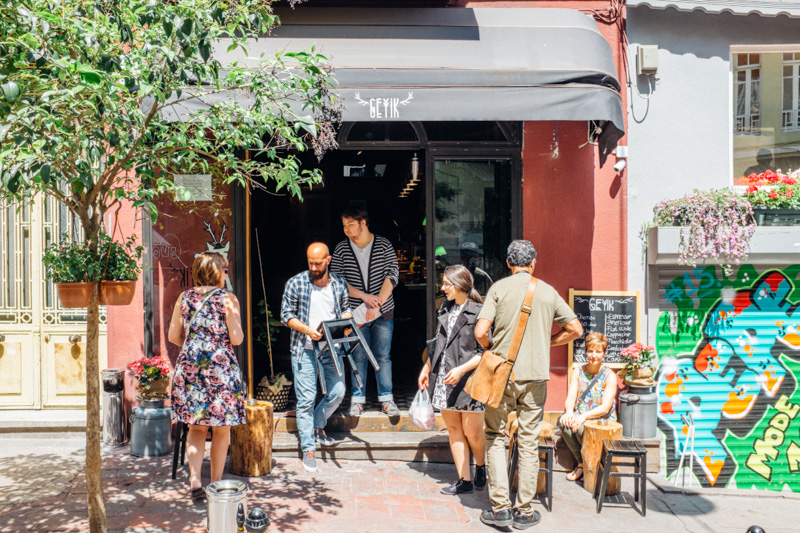
During evenings, Geyik operates as a bar and the fitout suits this perfectly. On weekends, breakfast is also offered and, if you’re really keen, you can partake in one of their coffee appreciation workshops.
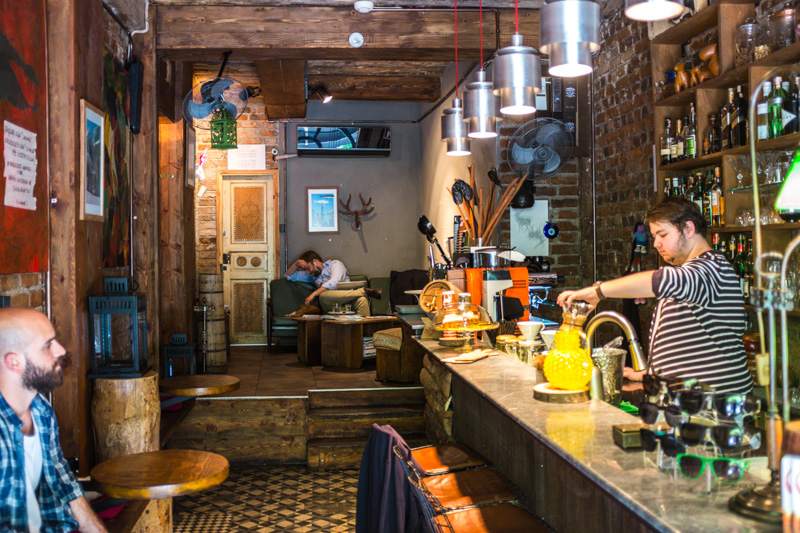
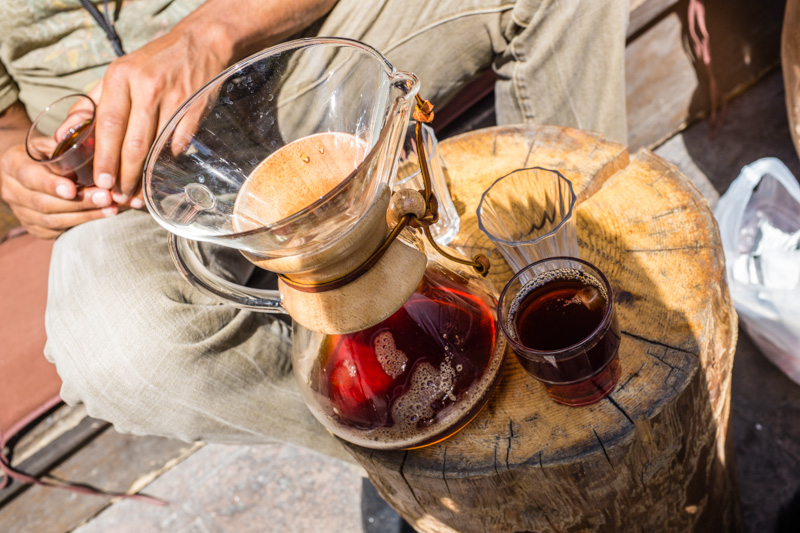
Geyik
Akarsu Caddesi, No 18
Beyoğlu, İstanbul

Brew Lab
We didn’t get a chance to grab a coffee from Brew Lab but it’s yet another third wave coffee shop that is highly regarded. It’s all about the coffee here, with every kind of style imaginable on offer. Food wise, it’s only a small selection of pastries and cakes that are available.
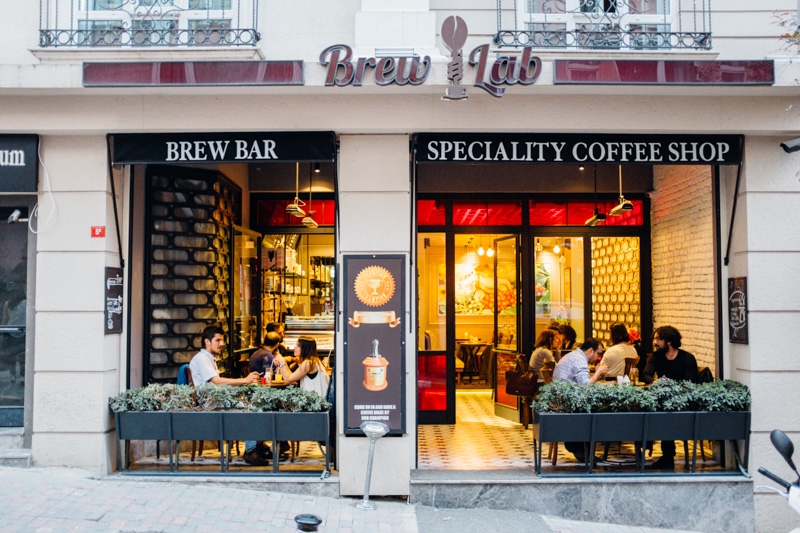
Brew Lab
Yeni Çarşı, Caddesi No:5
Beyoğlu, İstanbul

Tebessum Café
This is a cafe that we stumbled across walking down a street in a university district and we had to include it here because of its rooftop. The cafe is clearly aimed at the youthful, student crowd, with the bottom floor full of people playing arcade games. Walk up a few flights of stairs to the rooftop and you’re transported to an extremely chilled out lounge area. Grab a beanbag, order a drink and chill out.
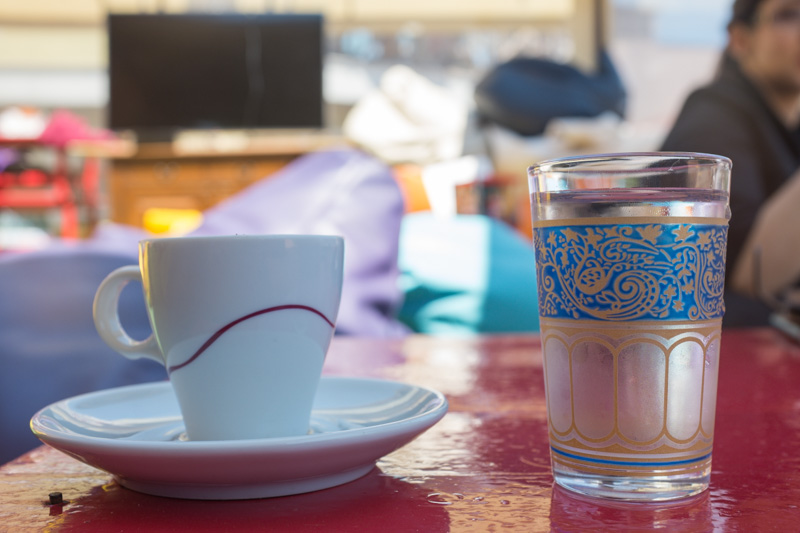
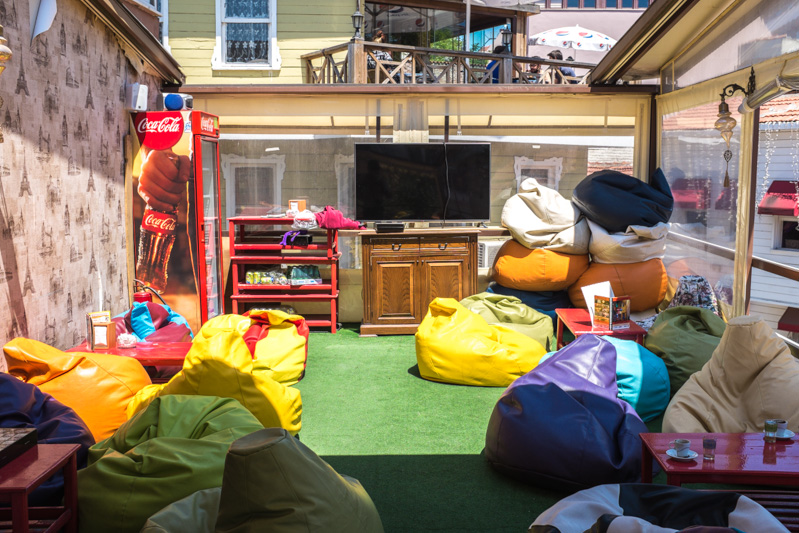
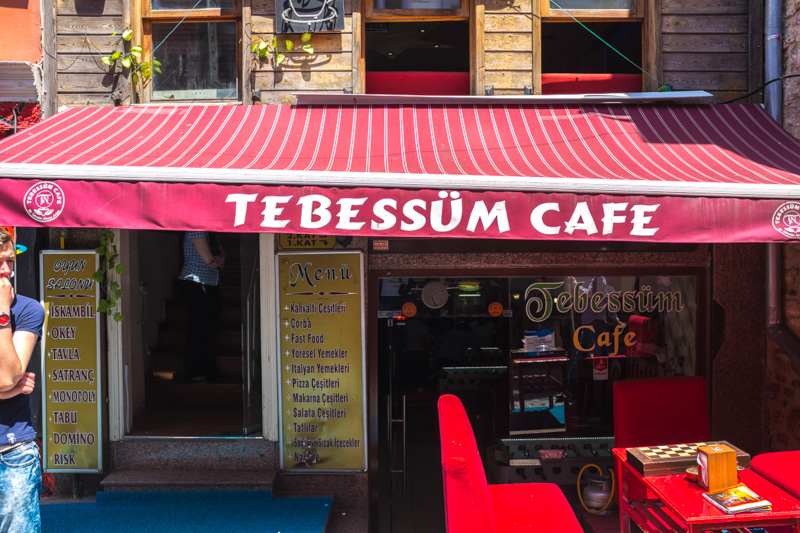
Tebessum Café
Cemal Yener Tosyalı Caddesi, No 69
Fatih, İstanbul

Pide
Pide is the Turkish name for pita and is the round, soft, slightly leavened flat-bread that many will be familiar with. It’s very common in Turkey, either to wrap kebabs or to eat with dips and you’ll find it at most places that you eat lunch or dinner at. Another common way that pide is prepared is somewhat like a pizza, with a filling, usually meat or cheese, placed on top or inside of the dough before baking.
Fatih Karadenize Pidecisi
This 3 storey pide restaurant has been providing Istanbul locals with their fill of some of the best pide in town since 1957. The menu is very simple, with only 10 or so types of pide on offer. We went for the open faced cheese (peynirli) pide with egg and the mince (kiymali) pide and egg. You can smell the pide baking as you sit and wait and, when the food does reach your table, you’re not disappointed.
The exterior of the pide is crispy, and the interior is soft and chewy. Egg is optional for all of the pide on offer here but seeing the raw egg crack open and cook on top of the pide on the tables around you, you know that it’s an option you need to choose. Simple indulgence at its best, and one of the best things that we ate in Istanbul.
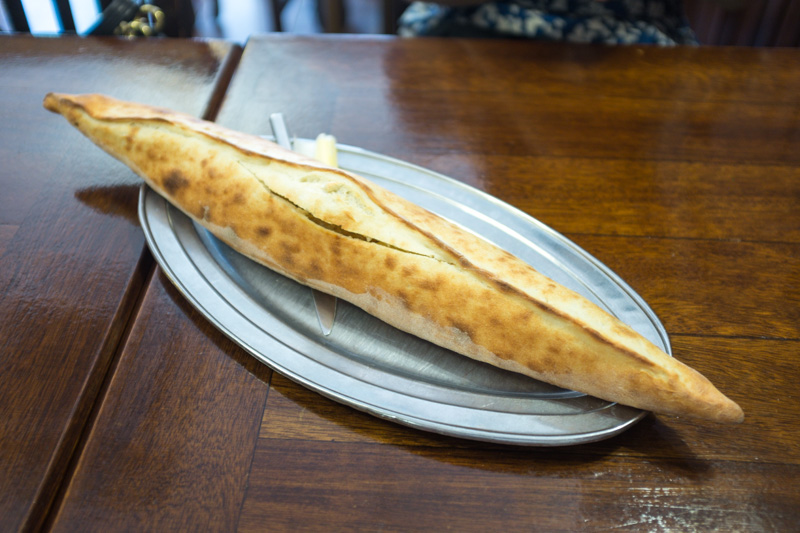
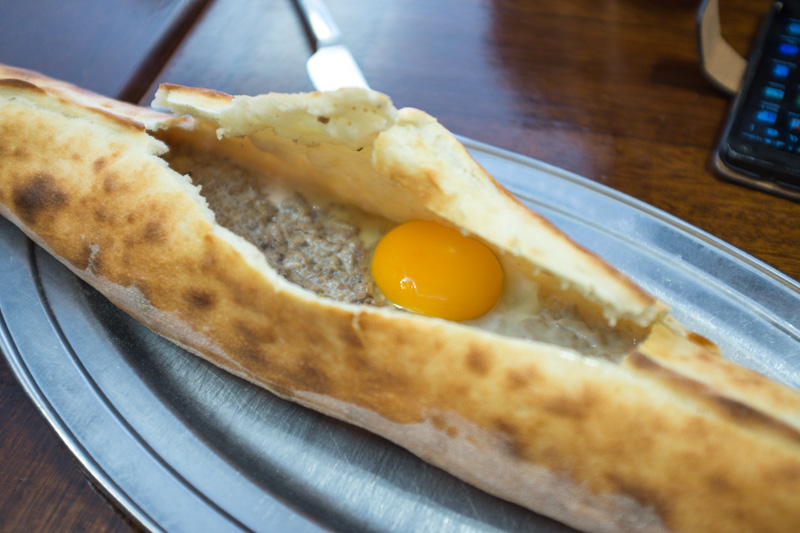
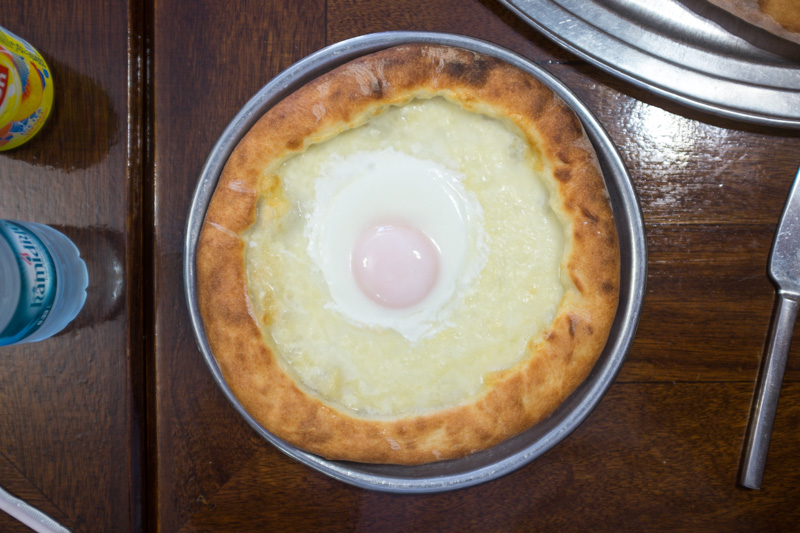
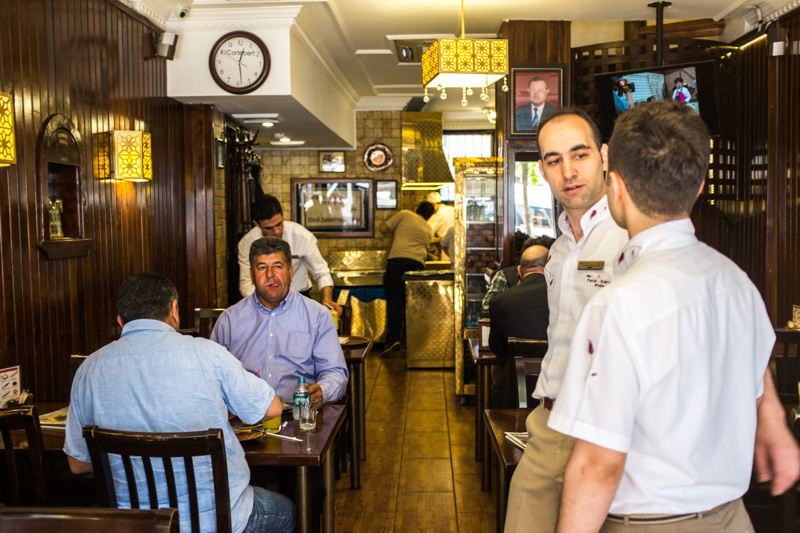
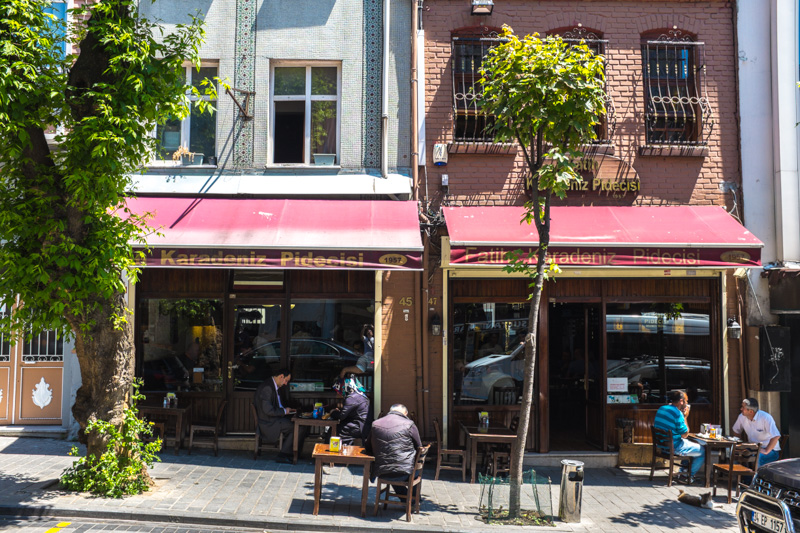
Fatih Karadenize Pidecisi
Büyük Karaman Caddesi, No 45/47
Fatih, İstanbul

Börek/Gozleme
Börek is very common in Turkey, and varies slightly by region – usually it’s the ingredients used or the shape that’s different. In Istanbul, it’s easy to find varieties from all over the country. What exactly is börek? It’s a baked, filled pastry made with thin, flaky layers of filo pastry (or yufka). The layers are coated with oil or butter and filled with mince, spinach, feta or a similar white cheese.
There are lots of hole in the wall places where you can find börek, such as the place below. It’s common at many cafes and restaurants too. The spinach börek we ate at Van Kahvati Evi when we were out for breakfast was great for example – not too heavy or oily with the right proportion of pastry to filling.
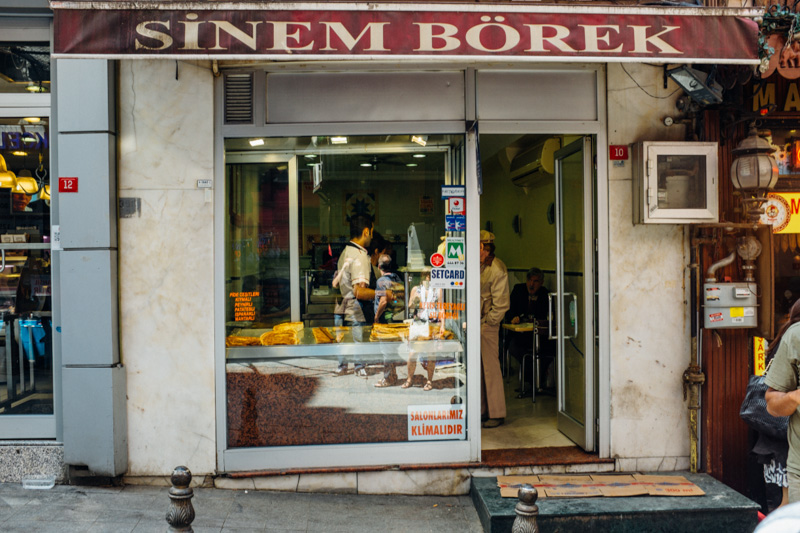
Gozleme can also be found throughout Istanbul. It’s similar to börek however it uses lightly grilled, thin flat bread which is filled and sealed before grilling.
Meze
Meze are a selection of small dishes, usually meant to accompany alcohol as snacks or as an entree before a main meal. There are a wide range of meze that can be found in Turkey, ranging from meat dishes to vegetable dishes, dips to cheese and olives, and a whole lot in between. The number of meze options is so large that it could easily warrant its own post. Some of the most common include:
- beyaz peynir (white cheese)
- kavun (sliced ripe melon)
- acılı ezme (hot pepper paste often with walnuts)
- haydari (thick strained yogurt with herbs)
- patlıcan salatası (cold eggplant salad)
- kalamar tava (fried calamari or squid)
- midye dolma and midye tava (stuffed or fried mussels)
- enginar (artichokes)
- cacık (yogurt with cucumber and garlic)
- dolma or sarma (rice-stuffed vine leaves or other stuffed vegetables, such as bell peppers)
- arnavut ciğeri (a liver dish, served cold)
- çiğ köfte (raw meatballs with bulgur)
Çiya Sofrası
From the outset, let me tell you that this place, which is located in the fish market district of Kadiköy, does not serve the best meze in Istanbul. We had better meze at the other restaurants that we ate at however what Çiya Sofrası does offer is one of the largest ranges of meze in town. Indeed, there were a lot of dishes here that we didn’t see elsewhere in the city, at least not all in the same place at the same time.
This place comes up on a lot of tourist guides and as a result is very popular with tourists – on the night that we visited there were barely any locals inside. I’ve included it however so you can see what some of the meze dishes that don’t appear elsewhere on this post look like.
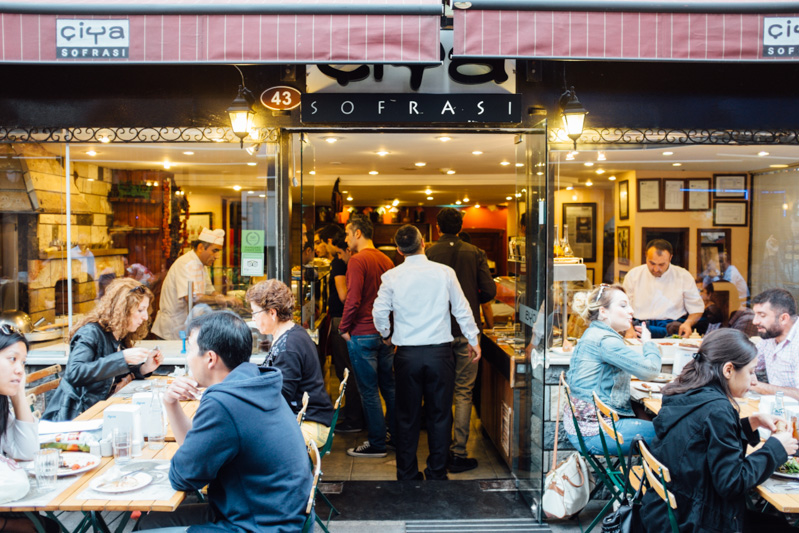
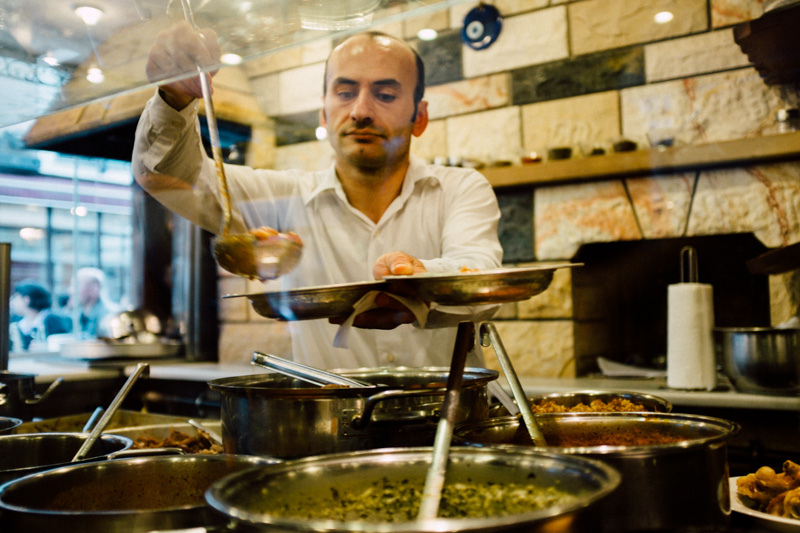
Braised spinach
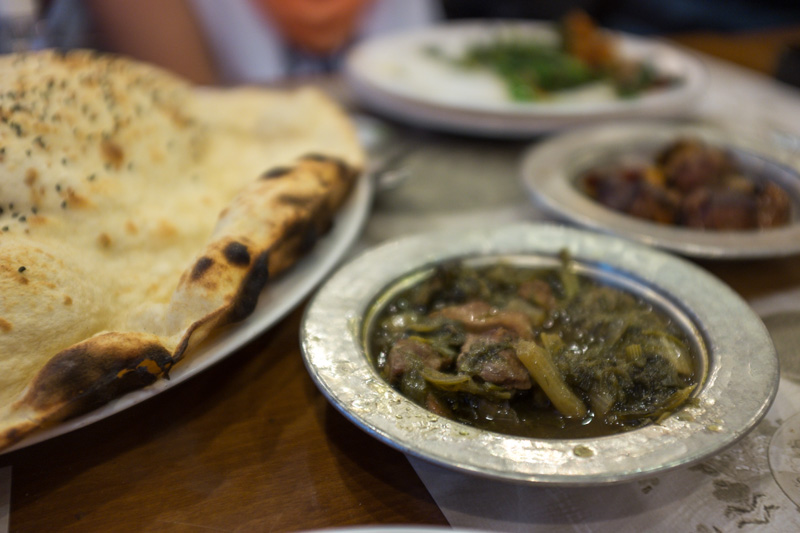
Etli Taze Fasulye (green beans stew with meat)
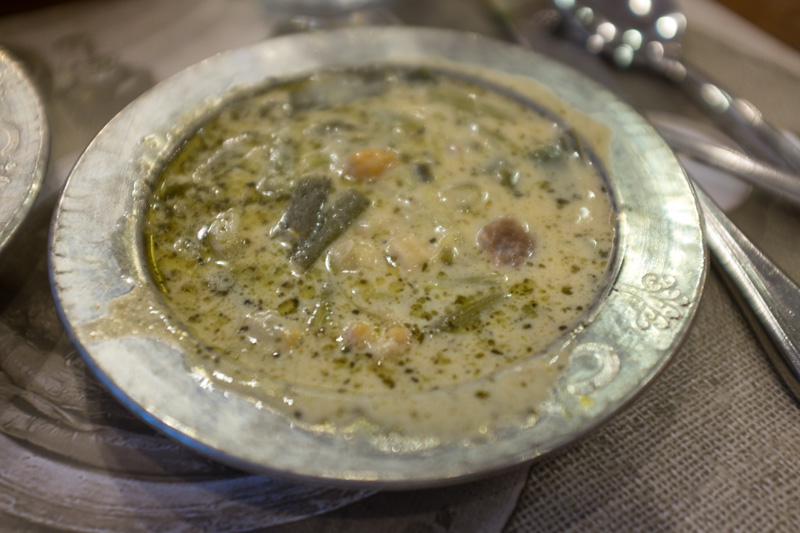
Mercimekli kofte (Bulgur wheat balls)
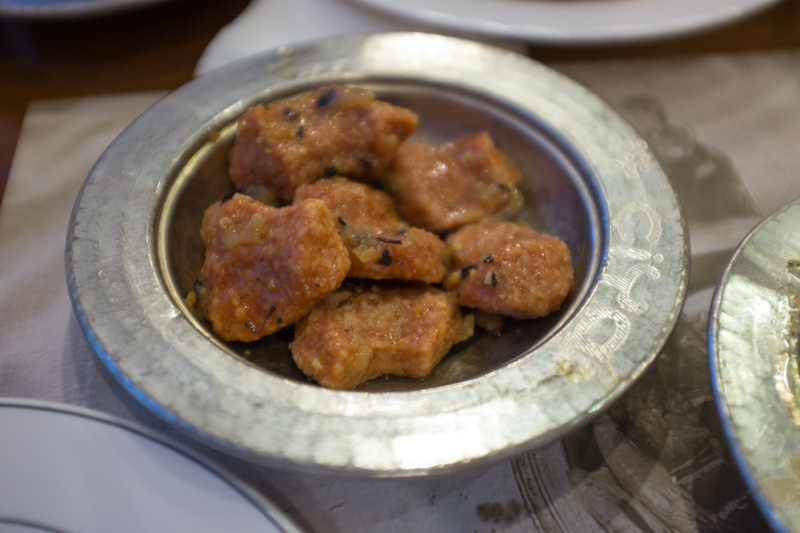
Sucuk (raw spicy sausage)

Felafel
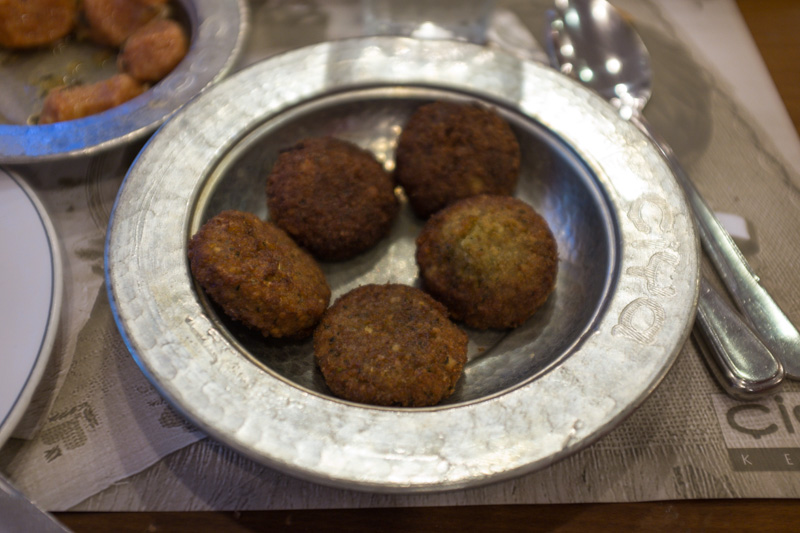
Çiya Sofrası
Güneşli Bahçe Sokak, No:43
Kadıköy, İstanbul

Milk-Based Desserts
Beyond the baklava, Turkish delight and usual cakes, tarts and biscuits that are common in Turkey is something quite unique and that is Turkish milk-based desserts – generally puddings of some sort.
Özkonak Muhallebicisi
This place has been serving up puddings (and savoury lunches) since the 1960s and is rightfully famous, with its puddings having a reputation as some of the best in the city. We couldn’t decide which to try so we got the 3 the man behind the counter said were the most popular.
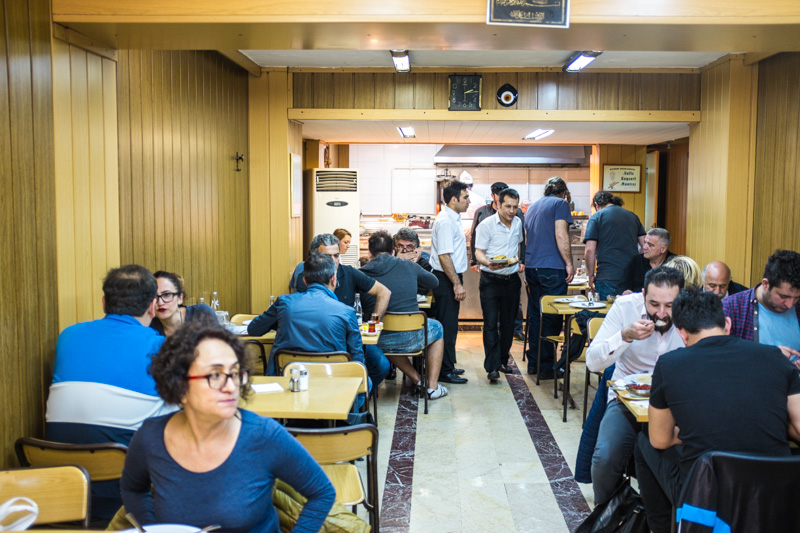

The 3 puddings, clockwise from top left to bottom, were:
- kazandibi – burnt milk pudding
- sütlaç – rice pudding
- tavuk göğsü – chicken breast pudding
I quite enjoyed all 3 puddings. The burnt milk pudding was very sweet and tasted quite plain while the rice pudding had a nice texture and flavour to it – not unlike other rice puddings I’ve tried before. We all enjoyed those 2 puddings but the 3rd, the chicken breast pudding, was divisive. We had no idea what to expect with this and upon trying it the first thing that was unusual was the texture – gluey is the best term I can use to describe it. Flavour wise it was sweet and very tasty – hints of vanilla with just the slightest flavour of, you guessed it chicken breast. Not for everyone, but I was a fan.
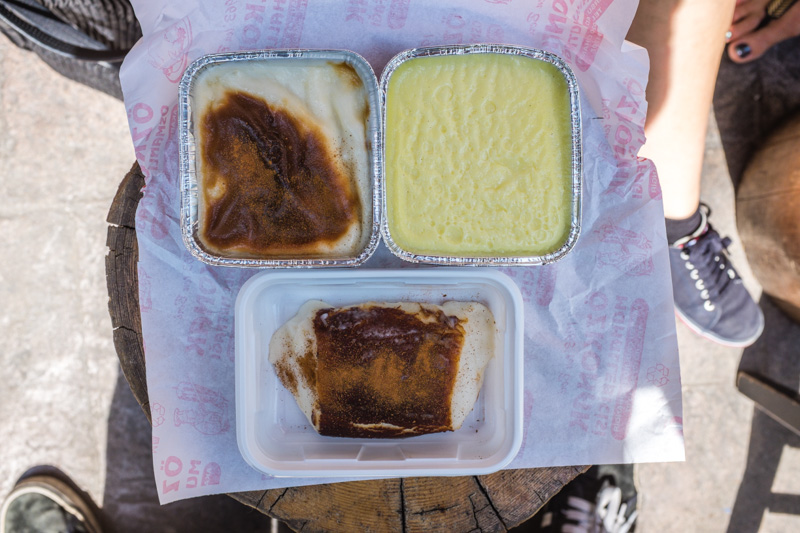
Özkonak Muhallebicisi
Akarsu Caddesi, No 46/B
Beyoğlu, İstanbul
Drinking (Alcohol)
Turkey might be a predominantly Muslim country but there are not shortage of places to find alcohol, with beer, wine and spirits being ready available all over Istanbul. Efes and Bomonti are the 2 most common beer brands you’ll see in Turkey – nothing special but they do the trick. There is also Turkish craft beer but it’s not easy to find.
The national alcoholic drink of Turkey is Raki, which is an unsweetened, anise flavoured drink. It’s usually drunk with water – it’s clear but when added to water turns milky white. It’s quite tasty but the aniseed flavour is strong. If you don’t like Sambucca or Ouzo you won’t like Raki.
Finally, wine is very popular in Turkey and in fact the country is home to several wine growing regions that make great quality local wines.
Solera Winery
One of the best places to sample Turkish wines is Solera winery, which has an extensive selection of exclusively Turkish wines on offer. The owner really knows his stuff and if you tell him the kind of wines that you like he’ll take you on a tour of the various wine producing regions of Turkey, finding a drop to suit your taste.
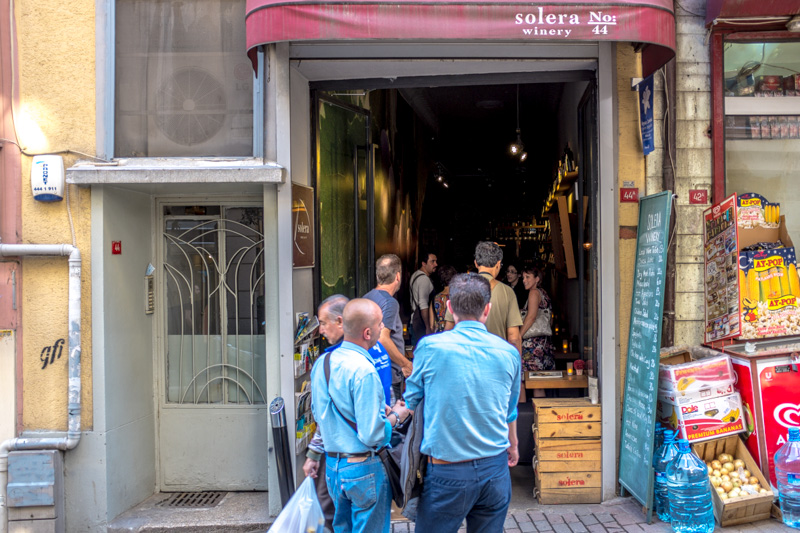
We may have finished off a few bottles while at Solera.
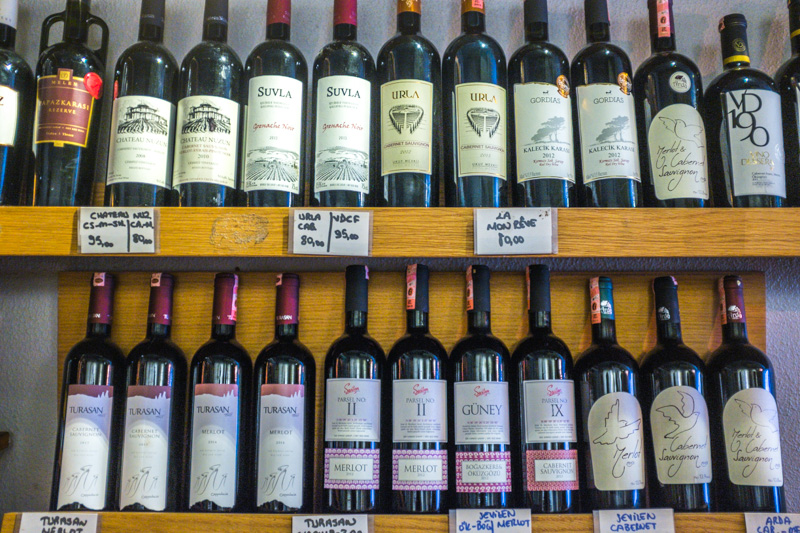
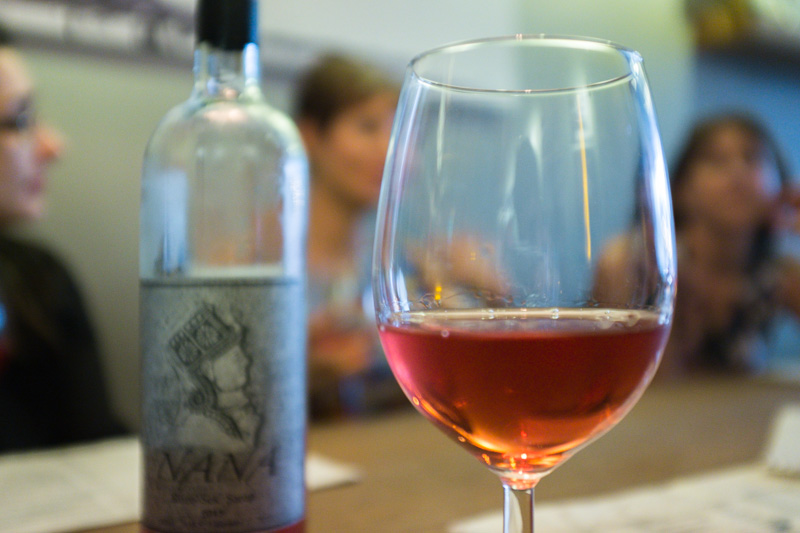
A small selection of food is also offered, including this tasty cheese board.
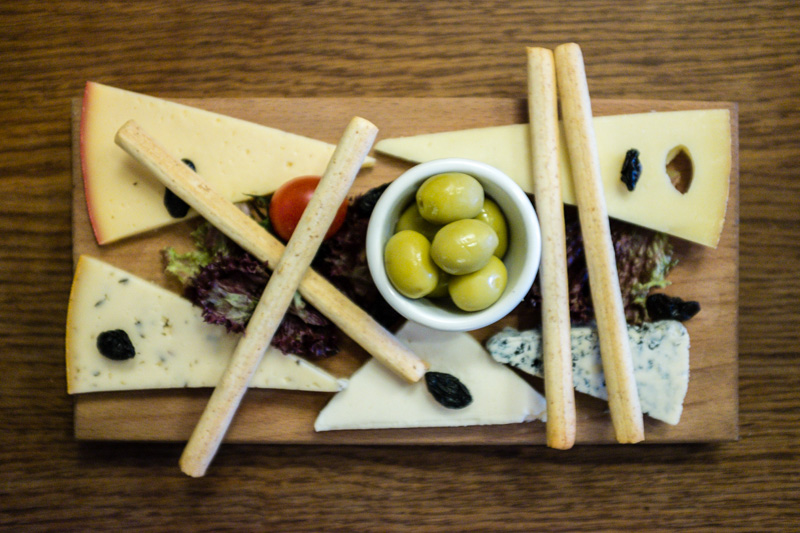
Solera Winery
Yeniçarşı Caddesi, No 44
Beyoğlu, İstanbul

Seafood
Given its location along the surprisingly blue Bosphorus, and indeed the abundant coastline that the country has, seafood isn’t hard to come by in Istanbul. While it can at times seem that seafood takes a back seat to meat, it’s easily found if you want some, indeed many a seafood restaurant can be found along the Bosphorus. The most popular kinds of seafood in Turkey are anchovies, sardines, calamari and whiting.
Balik Ekmek
This is one place that we really wanted to try but simply ran out of time. Balik means fish and Ekmek means bread. Each morning on both the Eminonu and Karakoy sides of the Galata Bridge, little stalls with grills and “Balik Ekmek” signs set up shop, selling simple sandwiches of bread filled with fresh caught and grilled mackerel, salted and sprinkled with red pepper, served with onion, lettuce, and a wedge of lemon. It sounds like simple deliciousness and by all accounts it is. Make sure you have one for me and let me know how it was in the comments below.
Balik Ekmek
Galata Bridge, Eminonu and Karakoy sides
Fatih, İstanbul
So there you have it, your one stop guide on where and what to eat in Istanbul. Have you been to Istanbul before? We’d love to hear about your food experiences and recommendations in the comments below.
